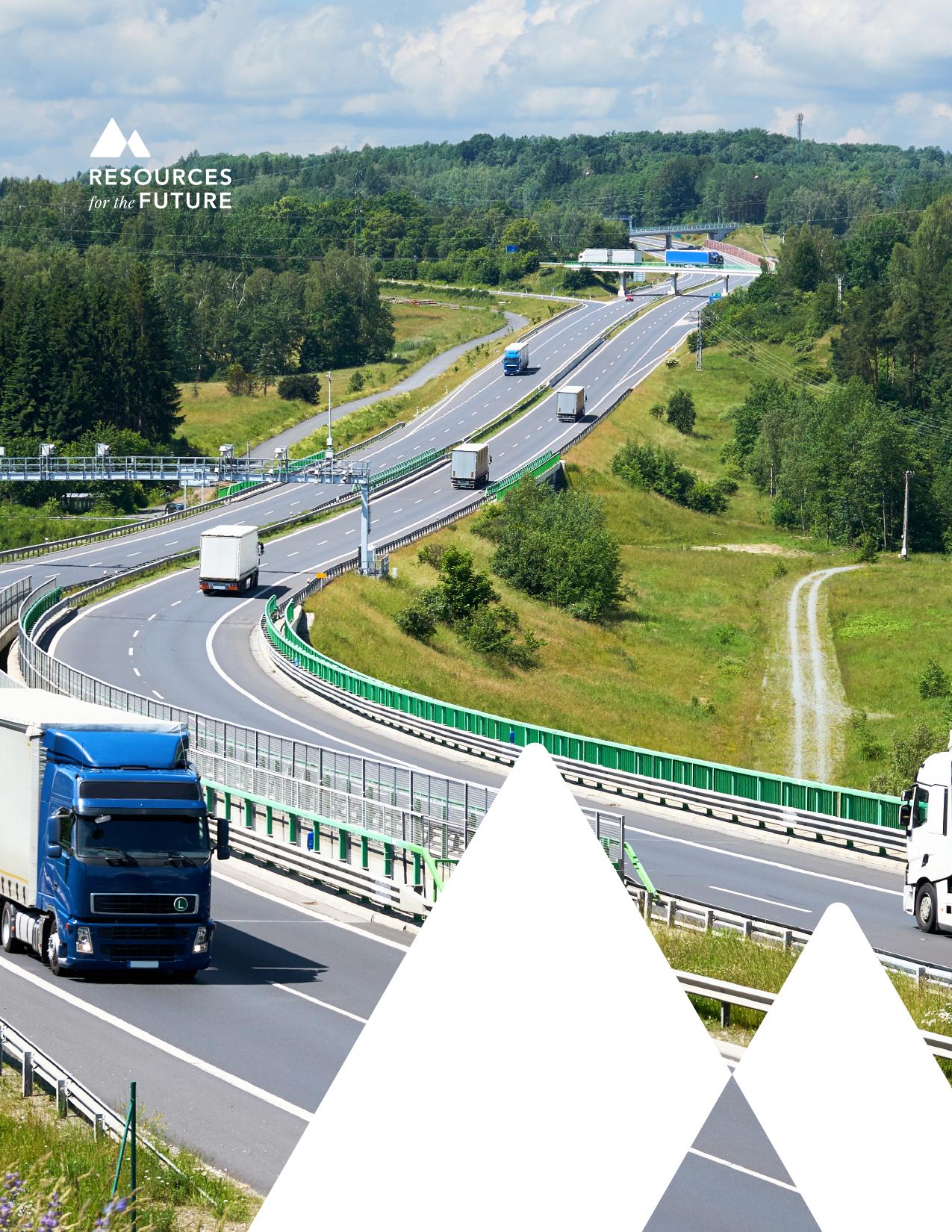Medium-andHeavy-DutyVehicleElectrification:Challenges,PolicySolutions,andOpenResearchQuestionsAMedium-andHeavy-DutyVehicleElectrification:Challenges,PolicySolutions,andOpenResearchQuestionsBeiaSpiller,NafisaLohawala,andEmmaDeAngeliReport23-03May2023ResourcesfortheFutureiAbouttheAuthorsBeiaSpillerisafellowandtheTransportationProgramdirectoratResourcesfortheFuture(RFF).PriortojoiningRFF,shewasLeadSeniorEconomistatEnvironmentalDefenseFund,wheresheworkedforalmostadecade.Spillerisanenergyeconomistwithexperienceworkingonelectricityandtransportationissuesandparticipatinginelectricutilityproceedings.Shealsohasmanyyearsofexperienceworkinginthetransportationsector,withrecenteffortsfocusingonelectricvehiclesandenvironmentaljusticeandexploringtheadoptionofelectriccars,trucks,andbuses.NafisaLohawalaisafellowatResourcesfortheFuture.SheearnedaPhDineconomicsattheUniversityofMichiganafterreceivingaBS-MSdualdegreeineconomicswithaminorincomputerscienceandengineering(algorithms)fromtheIndianInstituteofTechnology,Kanpur.Lohawala’sresearchliesattheintersectionofindustrialorganization,energyeconomics,andpublicfinance.Shefocusesontheeffectofgovernmentpoliciesonenvironmentalandsafetyexternalitiesgeneratedbythetransportationsector,aswellasothertransportationissues,includingdecarbonizationstrategiesformedium-andheavy-dutyvehicles.EmmaDeAngeliisaresearchanalystatResourcesfortheFuture.ShegraduatedfromtheUniversityofOklahomain2020withaBAinmathematicsandaBMAincelloperformance.ShethenearnedhermasterofenvironmentalmanagementdegreewithaspecializationinenvironmentaleconomicsandpolicyfromDukeUniversityin2022,focusingoncommunity-basedenvironmentalmanagementandclimatechangepolicy.Herpreviousresearchfocusedonincorporatingequityintostateregulatoryimpactanalyses.AcknowledgementsTheauthorswouldliketothankthefollowingorganizationsfortheirinputandassistanceinwritingthispaper:NYSERDA,NREL,PG&E,ConsolidatedEdison,VolvoTrucksNorthAmerica,CALSTART,EnvironmentalDefenseFund,andCummins.Allerrorsareourown.Medium-andHeavy-DutyVehicleElectrification:Challenges,PolicySolutions,andOpenResearchQuestionsiiAboutRFFResourcesfortheFuture(RFF)isanindependent,nonprofitresearchinstitutioninWashington,DC.Itsmissionistoimproveenvironmental,energy,andnaturalresourcedecisionsthroughimpartialeconomicresearchandpolicyengagement.RFFiscommittedtobeingthemostwidelytrustedsourceofresearchinsightsandpolicysolutionsleadingtoahealthyenvironmentandathrivingeconomy.TheviewsexpressedherearethoseoftheindividualauthorsandmaydifferfromthoseofotherRFFexperts,itsofficers,oritsdirectors.SharingOurWorkOurworkisavailableforsharingandadaptationunderanAttribution-NonCommercial-NoDerivatives4.0International(CCBY-NC-ND4.0)license.Youcancopyandredistributeourmaterialinanymediumorformat;youmustgiveappropriatecredit,providealinktothelicense,andindicateifchangesweremade,andyoumaynotapplyadditionalrestrictions.Youmaydosoinanyreasonablemanner,butnotinanywaythatsuggeststhelicensorendorsesyouoryouruse.Youmaynotusethematerialforcommercialpurposes.Ifyouremix,transform,orbuilduponthematerial,youmaynotdistributethemodifiedmaterial.Formoreinformation,visithttps://creativecommons.org/licenses/by-nc-nd/4.0/.ResourcesfortheFutureiiiAbstractMedium-andheavy-dutyelectricvehicles(MHDEVs)areapromisingsolutiontodecarbonizingourtransportationsector.Notonlyisthetechnologyadvanced,butmultiplestakeholdersaregeneratingmomentumfortheadoptionofcleanvehicles.However,manychallengesremain.Inthispaper,wedescribetheeconomicsofadoption,electricvehiclelogisticsandoperations,vehiclemanufacturing,requiredinfrastructureinvestments,barrierstoanequitabletransition,andbothpositiveandnegativeexternalities.Wealsodiscusslow-carbonalternativestodieselvehicles.Wenextdiscusspolicysolutionsforthechallenges(includingbothexistingandpotentialpolicies).Finally,basedonourliteraturereview,wepresentopenresearchquestionswhoseanswerswouldhelpresolvethechallenges.Medium-andHeavy-DutyVehicleElectrification:Challenges,PolicySolutions,andOpenResearchQuestionsivContentsExecutiveSummary�1Challenges�1AlternativeTechnologies�2PolicySolutions�2OpenQuestions�31.Introduction�61.1.MomentumacrossStakeholders�61.2.TechnicalFeasibility�72.Challenge#1:MakingtheEconomicsofMHDEVAdoptionWork�82.1.UpfrontCosts�82.2.OperatingCosts�93.Challenge#2:TheFleetPerspective:Logistics,Operations,andVehicleAdoption�103.1.Range�103.2.RechargingTime�113.3.PayloadReduction�123.4.VehicleandInfrastructureMaintenance�124.Challenge#3:ManufacturingChallenges�124.1.LowDemandandEconomiesofScale�124.2.IdiosyncraticManufacturingProcesses�134.3.ChangingBatteryTechnology�144.4.HeterogeneityacrossVehicleUseCases�144.5.SupplyChainRestrictions�155.Challenge#4:InfrastructureInvestmentRequirements�165.1.LocalElectricityDistribution�165.2.GridReliabilityandTransmission�185.3.GenerationExpansionNeeds�185.4.ChargingStationInvestments�186.Challenge#5:MakingtheTransitionEquitable�196.1.OwnershipandAffordability�206.2.AbilitytoAccessIncentivesandNavigatePrograms�206.3.TechnicalandManagementSupportforFinancialDecisions�20Medium-andHeavy-DutyVehicleElectrification:Challenges,PolicySolutions,andOpenResearchQuestionsv7.Challenge#6:ExternalitiesoftheTransition�217.1.ExternalitiesforSalesandUse�217.2.R&DExternalities�227.3.EnvironmentalExternalitiesofEnerySupply�228.AlternativestoElectrification�238.1.HydrogenFuelCellElectricVehicles�238.2.Biodiesel�238.3.HybridTrucks�249.PolicySolutionstoMaximizetheSocial,Environmental,andEconomicBenefitsoftheTransitiontoMHDEVs�249.1.LoweringUpfrontCostsofAdoption�259.1.1.ReducingVehiclePurchaseCosts�259.1.2.InvestinginChargingStations�269.1.3.LoweringCostofEntry�279.1.4.IncreasingDemandofMHDEVs�289.1.5.Public-PrivatePartnerships�289.2.ManagingOperatingCostsandChallenges�299.2.1.RestructuringElectricityTariffs�299.2.2.GeneratingExtraRevenueforFleets�299.2.3.AdoptingManagedCharging�309.2.4.PromotingCo-LocatedSolarandStorage�309.2.5.EqualizingFuelCostsacrossVehicleTypes�319.2.6.AllowingWeightRegulationExemptions�319.3.ImprovingOn-RouteChargingOptions�329.3.1.InvestinginPublicChargingStations�329.3.2.StandardizedBatterySwapping�339.3.3.InstallingCatenaryCharging(ElectricRoadSystems)�339.4.DealingwithExternalities�339.4.1.AligningPrivateandPublicIncentivesforFleetsandManufacturers�349.4.2.EnsuringGreenGenerationCapacity�349.4.3.SubsidizingBatteryR&D�349.5.IncreasingAdoptionbySmallFleetsandFleetsinEJCommunities�359.5.1.TargetingSubsidiestoSmallFleets�359.5.2.ProvidingOutreachandLeveragingCommunityGroups�359.5.3.SubsidizingManagedChargingSoftwareandCo-LocatedSolarandStorage�35Medium-andHeavy-DutyVehicleElectrification:Challenges,PolicySolutions,andOpenResearchQuestionsvi10.OpenQuestions�3610.1.VehicleUseandOwnership�3610.2.ManufacturingandSupplyChains�3810.3.PublicChargingStations�3911.Conclusion�4012.References�42Medium-andHeavy-DutyVehicleElectrification:Challenges,PolicySolutions,andOpenResearchQuestions1ExecutiveSummaryTrucksandbusesaredisproportionatelylargecontributorstoairpollutionandgreenhousegasemissions.Thoughonlyabout5percentoftotalvehiclesonUSroads,in2020theyaccountedforapproximately26percentofthetransportationsector’sgreenhousegasemissions.Electrictrucksandbusesareapromisingsolutionbutfacemanyhurdles.Basedonaliteraturereview,interviews,andlearningsfromaconferenceonelectrification,thispaperidentifiesmajorchallenges,policiestoaddressthem,andopenquestionsforfurtherresearch.ChallengesCoststofleets.Thetotalcostofownership(TCO)ofmedium-andheavy-dutyelectricvehicles(MHDEVs)needstobecompetitivewiththatofdieselvehicles.Theirpurchaseprice,however,ismuchhigher,andchargingstationinstallationcanexceed$100,000.Rechargingcostsdependonelectricitytariffsandthuscanvarybylocation.MHDEVmaintenancecostsaregenerallylower,butfleetsmayneedspecializedworkers.Vehicles’residualvaluedependsonbatterydegradationanddemandforusedMHDEVs—factorsthatarecurrentlyunknown.Logisticsandoperations.MHDEVsmustbecomparabletodieselvehiclesinmodeloptions,range,rechargetime,payloads,andmaintenance.MHDEVsgenerallyhaverangesbelow200miles,versusmorethan1,000milesfordieselvehicles.Rechargetimesaresubstantiallylongerthandieselrefueling,andfleetswithoutdepotsneedpublicchargingstations.MHDEVsalsoweighmore,whichmaymeanlesspayload.AllthesefactorscouldincreasetheirTCOrelativetodiesel.Manufacturingchallenges.ManufacturersofMHDEVsmustcreateproductiontoolsandprocessesfromscratch.Asbatterytechnologyimproves,eachchangenecessitatesnewequipmentandvehicleconfigurations.Withlowdemand,manufacturersareuncertainaboutprocurement;fleetsareuncertainaboutmanufacturers’longevity.Thesmallnumberofmanufacturersineachvehicleclassandusecategorygivesmakersmarketpowertokeeppriceshigh.Assalesgrow,thepaceofminingexplorationanddevelopmentforcriticalmineralsmayberestrictive.Infrastructurerequirements.MHDEVcharging(whichmayexceedseveralMWsofdemandforlargefleets)coulddestabilizeelectricitydistributionsystems.Investmentsinthegrid,transmissionsystem,andgenerationcapacityarerequired.Long-haulfleetswithoutdepots,aswellassmallfleetsandowner-operatorsforwhomchargingstationsarecost-prohibitive,willrequiremidday,on-routefill-upsatpublicchargingstations.Publicstationscanalsonecessitateinvestmentsinthegrid,butMHDEVtrafficflows,andthusloads,areunpredictable.Tomaximizeenvironmentalbenefits,thenewgenerationusedforchargingwillneedtocomefromrenewablesources.ResourcesfortheFuture2Equity.SmallfleetswilllikelypurchaseMHDEVsinthesecondarymarketandthereforenotbenefitfromincentivesfornew-vehiclebuyers.SmallfleetsalsofacebureaucraticandadministrativehurdlesbecausetheylackthestaffingtotakeadvantageofincentiveprogramsandoptimizeTCOafterpurchase.Externalities.AdoptionofMHDEVscangenerateexternalities,bothpositiveandnegative.MHDEVsreducedependenceonimportedoilandcanimprovelocalairquality,butfleetownersareunlikelytointernalizesuchbenefits—orthesocialandenvironmentalcostsassociatedwithcharging.Researchbyonemanufacturercanbenefitothers,yetthesebenefitsareunlikelytobeinternalized,leadingtosuboptimalinvestmentinR&D.AlternativeTechnologiesLow-carbonalternativestoMHDEVsmaybeneededforcertainapplications.Vehicleswithhydrogenfuelcellsorhybridtechnologywouldhaveshorterrefuelingtimesandlighterweight(i.e.,lesspayloadreduction).Biodieselfuelisanotheralternative;itdoesn’trequirefleetstopurchasenewvehicles,andithasthepotentialforreducingemissions(thoughitcanhaveunintendedconsequences,suchasland-usechanges).PolicySolutionsOnegoalforpolicymakersistoincreaseMHDEVadoptionbyloweringmanufacturingandoperatingcosts.Somepoliciescanleveragemarketpower(e.g.,electricitytariffsthatincentivizemanagedcharging);otherslowerpricesdirectly(e.g.,purchaseincentives).Asecondgoalistomaximizetheeconomic,environmental,andsocialbenefitsofelectricvehicles.Here,welistpolicyoptionstohelpincreaseadoptionwhilemaximizingbenefitstosociety.Loweringupfrontcosts.Subsidiescanpromoteelectrificationbyloweringcostsforpurchaseandcharginginfrastructure.Giventheimportanceoffastchargingforcommercialfleets,supportforLevelIIIchargingmaybecrucial.Incentivesformanufacturerstoaddmodels(e.g.,zero-emissionvehiclecreditsinCAFEstandards,electricvehiclemanufacturingtaxcredits)wouldlowerentrycostsandencouragediversification(tolimitmarketpower).Fleetmandatescouldalsohelpmanufacturerspredictdemandandmakeprocurementmoreefficient.Managingoperatingcosts.LoweroperatingcostswouldmakeMHDEVsmoreaffordable,butreductionsmustnotincreasesocialcosts.Policymakershaveseveraloptions.Electricitytariffscanencouragefleetstoreducemaximumdemand(bychargingmoreslowly)andpeak-hourconsumption(bychargingoff-peak).Alow-carbonfuelstandardandvehicle-to-gridcontractscanearnextrarevenueforfleets.Automatedmanagedchargingsoftwareallowsfleetstorespondtopricesautomatically.Co-locatedsolarandstoragecanreducefleets’maximumdemandanddemandonthegrid.Finally,higherdieselfuelpricescanhelpsmooththedifferenceinoperatingcostsacrossvehicletypes.Medium-andHeavy-DutyVehicleElectrification:Challenges,PolicySolutions,andOpenResearchQuestions3Improvingon-routecharging.TheNationalElectricVehicleInfrastructureFormulaProgramprovidesfundingforchargingstations,butmoreinvestmentinlow-trafficareasisneeded.GreenloadingzonescouldprovidededicatedMHDEVparkingspaceswithchargingstations.Batteryswappingwouldenableefficientexchangeofadepletedbatterywithafullychargedone.Electricroadsystemscouldaddressthechallengeoflongchargingtimes,particularlyforMHDEVswithoutdepots.Dealingwithexternalities.Thenewgenerationcapacityrequiredtomeetincreaseddemandshouldbeclean.Policiesthatpromotecleanelectricitysimultaneouslywithacleantransportationsystemincludecarbontaxes,renewableportfoliostandards,andcap-and-tradeprograms.Incentivesforco-locatedstorageandsolarandmanagedchargingsoftwarecouldalsohelpreduceemissionsassociatedwithcharging.Increasingadoptionbysmallfleets.Technicalassistancecanhelpsmallfleetsandoperatorsinenvironmentaljustice(EJ)communitiessurmountlogisticalchallenges.Subsidiesshouldbetailoredtosmallfleetsandfleetsinlow-andmoderate-incomeandEJcommunitiesandincludefinancingformanagedchargingsoftwareandco-locatedstorageandsolar—investmentstohelpsmallfleetsgoelectricwhilealsoreducingeffectsonthegrid.OpenQuestionsTheuncertaintiesintheMHDEVmarketmakeitchallengingtocraftpoliciesthatpromoteefficient,effective,andequitableoutcomes.Ourworkhasidentifiedopenquestionsfortheresearchcommunity.Vehicleuseandownership.Answerstothesequestionscaninformpoliciestoencouragefleetadoption.•HowdopurchaseandchargingstationsubsidiesaffecttheTCOofMHDEVs?•WhatistheoptimallevelforelectricitytariffstochangetheTCOandincentivizemanagedcharging?•WhatisthedepreciationrateforMHDEVs?Theresidualvalueofusedelectricvehicles?Howwilltruckpurchaseandownershippatternsshiftinresponse?•Howmuchwouldco-locatedstorageandsolarreducetheTCO?•Whatpaymentandcontractstructuresforvehicle-to-gridwouldmaximizecost-effectiveness?•HowwouldhigherdieselpricesaffectMHDEVadoption?Manufacturingandsupplychains.Answerstothesequestionscanhelppoliciesacceleratethetransitionwhilepromotingmarketefficiency.•WouldR&Dinvestmentsleadtogreaterentry,productofferings.andinnovation?•WhatisthevalueoftechnologicalspilloversintheMHDEVsector?•Howdoesmarketpoweraffecttruckprices?•HowaresuppliesandcostsofcriticalmineralsconstrainingdevelopmentofMHDEVs?ResourcesfortheFuture4Publicchargingstations.Answerstothesequestionscouldmakechargingstationinvestmentsmoreefficientandequitable.•Howdopubliccharginginvestmentsaffectadoptiondecisionsandinteractwithotherincentives?•Whatarethenetworkissuesfortheseinvestmentsandthechargingmarket?•HowcanpubliccharginginvestmentsmaximizebenefitstoEJcommunities?Table1summarizesthechallengestotheMHDEVtransition,possiblepolicysolutions,andopenquestions.Medium-andHeavy-DutyVehicleElectrification:Challenges,PolicySolutions,andOpenResearchQuestions5Table1.MHDEVChallenges,PolicySolutions,andOpenQuestionsChallengePolicySolutionsOpenQuestionsCoststofleets.Totalcostofownershipmustbefavorableforfleets,butupfrontcostsarehighandchargingstationinstallationcanbeexpensive.•Subsidies•Excisetaxremoval•Batteryleasing•Higherdieselprices•Smarttariffdesign•Managedcharging•Programstosupportextrarevenuestreams•Public-privatepartnerships•Effectofpoliciesontotalcostofownershipandadoptionoutcomes?•DepreciationrateandresidualvaluesofMHDEVs?•Economicopportunitiesofsolar-and-storageinvestments?•Roleofhigherdieselpricesinshiftingdemand?Logisticsandoperations.Fleetownersmustovercomelogisticalhurdles:shorterranges,longerrechargetimes,payloadreductions,lowavailabilityofmaintenanceworkers,limitedmodeloptions,operationalchanges.•Managedcharging•Batteryswapping•Publicchargingstationinvestments•Exemptionsfromweightregulations•Implicationsoftariffreform?•Effectofpublicchargingstationsonfacilitatinglogistics?Manufacturingbarriers.ManufacturingMHDEVsrequiresdevelopingnewtoolsandprocesses,gettingnewpermits,adaptingtonewbatterytechnologies,accuratelyassessingdemand,obtainingcriticalminerals.•IncentivesandloansformanufacturerstoaddZEVofferings•Researchanddevelopment•Subsidiesforbatterycapacity•ZEVfleetmandates•Effectofpolicysolutionsonproductioncosts,vehicleofferings,andinnovation?•R&Dspilloversacrossandwithinmanufacturers?•Marketpoweranditseffectonprices?•Supplyofcriticalmineralsandbatterytechnology?Infrastructurerequirements.IncreaseinMHDEVsnecessitatesmoreinfrastructureandassociatedinvestmentstolocalelectricitydistributiongrid,transmissionsystem,generationcapacity,andchargingstations.•Investmentinchargingstations•Investmentincatenarycharging•Reformingelectrictariffs•Co-locatedstorageandsolar•Chargingstationsubsidies•Effectofpubliccharginginvestmentonadoption?Interactionwithotherpolicies?•Networkissuesandspillovers?•Effectoftime-varianttariffsonpeakloadsandsystemcosts?Makingtransitionequitable.SmallfleetsmayfindithardertoadoptMHDEVsbecauseofuncertainsecondarymarket,bureaucraticandadministrativehurdles,lackofresearchstaff.•Smartchargingassistanceandsubsidies•PoliciestailoredtofleetsinEJcommunities•Subsidiesforusedvehiclesandsmallbusinesses•Outreachandeducation•Investmentinpublicchargingstations•OptimizingchargingstationinvestmentsinEJcommunities?•Effectofpoliciesonadoptionbysmallfleets?•Effectofpoliciesonused-vehiclemarket?Externalities.FleetownersmaynotinternalizeexternalbenefitsofadoptingMHDEVsortime-varyingcostsofelectricityconsumption.ManufacturersmaynotinternalizeR&Dexternalities.Energysuppliersmaynotinternalizebenefitsofsupplyingcleanelectricity.•Carbontaxes•Time-varyingelectricitytariffs•Renewableportfoliostandards•Cap-and-trade•Co-locatedstorageandsolar•Creditsinemissionsstandardspolicy•Salesmandates•SubsidiesforEVpurchase,manufacturing,andR&D•Environmentalbenefitsofco-locatedsolarandstorage?•Roleofhigherdieselpricesinshiftingdemand?ResourcesfortheFuture61.IntroductionMedium-andheavy-dutyvehiclesareanimportantpartoftheeconomy.Theyprovidelong-haulandlocaldelivery,transportpeopleandproducts,collectgarbage,supportconstruction,andmuchmore.Trucksandbusesalsoareasignificantanddisproportionatecontributortolocalairpollutionandgreenhousegasemissions.Infact,thoughtheyrepresentonlyasmallfractionoftotalvehiclesontheroad(approximately5percentintheUnitedStates1),in2020theycontributedapproximately26percentofgreenhousegasemissionscomingfromthetransportationsector.2Furthermore,COVID19ledtoanincreaseindeliveries,atrendshiftthatislikelytocontinueincreasingthecontributionofMHDVstotransportationsectoremissions.Truckandbusemissionstendtodisproportionatelyaffectenvironmentaljustice(EJ)communities,whicharelocatedclosertomajorroadwaysandthewarehousesanddepotswherethevehiclesarehoused.Reducingemissionsfromthissectorwillnotonlyimproveairqualityandreducethetransportationsector’scontributiontoclimatechange,itwillalsoimprovehealthandwell-beingincommunitieshistoricallyaffectedbytransportationpollution.Decarbonizingtrucksandbuses—toreducebothgreenhousegasesandlocalairpollution—isanimportantgoalforimprovingwelfare,health,andwell-beingacrossthenation,aswellasmitigatingclimatechange.Vehicleelectrificationisapromisingsolutionbecausethetechnologyhasnowdevelopedtosuchadegreethatmanyusecasescouldshifttoelectric;electricvehiclesareonthemarketandhavebeenproventowork.Manychallengesremain,however.Inthispaper,wedescribethechallenges,studywhatpolicieshavebeenorcouldbeleveragedtoaddressthesechallenges,andidentifyopenquestionsandgapsinknowledgethatcancontributetopolicymaking.MHDVelectrificationisoneofseveraloptionsavailabletodecarbonizethesector.Wechoosetofocusonthissolutionfortworeasons.1.1.MomentumacrossStakeholdersFirst,stakeholdersaregeneratingmomentumfortruckelectrification.Atthefederallevel,theUnitedStatesisapartoftheGlobalMemorandumofUnderstanding(MOU)onZero-EmissionMedium-andHeavy-DutyVehicles.ThisMOUcommitsparticipatingcountriestoworktogethertoachievenet-zerocarbonemissionsby2050bysettingagoalof100percentzero-emissionnewtruckandbussalesby2040,withaninterimgoalof30percentzero-emissionvehicle(ZEV)salesby2030.TheInflationReductionAct(IRA)of2022showscommitmenttothecauseandprovidesbillionsofdollarsinfundingforMHDVelectrificationthroughsubsidiesandgrantsforvehiclepurchases,chargingstationinvestments,andadvancedvehiclemanufacturing.1BureauofTransportationStatistics,“NumberofUSAircraft,Vehicles,Vessels,andOtherConveyances.”Availablehere.2USEnvironmentalProtectionAgency,“FastFactsonTransportationGreenhouseGasEmissions.”Availablehere.Medium-andHeavy-DutyVehicleElectrification:Challenges,PolicySolutions,andOpenResearchQuestions7Somestateshavetheirownplanstoachieveelectrification.NewYorkschoolbusesmustbeelectrifiedby2035.BothCaliforniaandNewYorkhavesetgoalsofachieving100percentzero-emissiontruckandbussalesby2045.InamultistateMOUfacilitatedbyNESCAUM,317statesandWashington,DC,haveagreedtoachieving30percentzero-emissiontruckandbussalesby2030.Thetruckingindustry,bothmanufacturersandfleetoperators,hasalsosetitssightsonelectrification.Tesladelivereditsfirstbatteryelectricheavy-dutysemitruckwitharangeof500milesonasinglecharge.Withapilotpartner,Volvoisbuildinganationalnetworkofpublicheavy-dutychargingstations.Newcompanies,suchasRivianandProterra,haveemergedthatexclusivelymanufactureMHDEVs.Manydieselvehiclemanufacturersarereleasingelectricoptionsandhavetheirowngoalsforelectricsales;Volvo,forexample,isaimingfor50percentelectricsalesby2030.Majorcompaniesandfleets,likeUSPS,PepsiCo,andAmazon,areputtinginpreordersforthousandsofelectrictrucksanddeliveryvans.TheelectricutilitiesinthiscountryhavejoinedthepushtowardMHDVelectrificationaswell.Manyutilitieshavestartedpilotsandprojectstoensureasmoothtransitiontovehicleelectrificationsothattheincreaseindemandfromthesevehiclescanbemetcost-effectively.Finally,communitiesaredemandingcleanerairandviewMHDEVsasimportantforachievingthisgoal.Electrificationofthissectorwillimprovethehealthandwell-beingofcommunities,particularlydisadvantagedandlow-incomecommunities,whichtendtobeclosertomajorroadways,warehouses,anddepotsandarethereforedisproportionatelyaffectedbytransportationpollution.41.2.TechnicalFeasibilitySecond,electrificationisfeasible.Thepotentialfordecarbonizationarisesfromtheabilityofelectricvehicles(EVs)toconvertenergyintomovementatamuchhigherefficiencyratethandieselvehicles.Furthermore,electrictechnologyhasrapidlyadvanced.Withgrowthinlight-dutyEVadoptionandmanufacturing,batterytechnologyhasimprovedsignificantly,leadingtocostreductionsof97percentoverrecentdecades.5TheseadvancementscanbringcostsavingstotheMHDVsectoraswell.ThecollectiveefforttoelectrifytheMHDVsectorandthetechnologicalpotentialofthesevehiclesbodewell,butthetransitionmustbeeffective,efficient,low-cost,andequitable.Anoptimaltransitionstartswithafullunderstandingofthechallengesfacedbyutilities,manufacturers,fleets,andcommunities.Policiescanthenbecraftedtotargetandreduce3NortheastStatesforCoordinatedAirUseManagement,anassociationofairqualityagenciesinNewEngland,NewJersey,andNewYork.4See,forexample,publicsupportforelectricschoolbusesbyWeACTforEnvironmentalJustice(acommunityorganizationbasedinWestHarlem,NewYorkCity);andacallforfulltruckelectrificationinCaliforniabyagroupofmorethan70organizations,includinglocalenvironmentaljustice,labor,andhealthgroups.5Thepriceofbatterieshasdeclinedby97percentinthelastthreedecades;OurWorldinData.ResourcesfortheFuture8theimpediments.Basedonanexplorationoftheexistingliterature,multiplestakeholderinterviews,andlearningsfromaconferencepaneldealingwithMHDVelectrification,6thispaperidentifiesthechallengesandthepoliciesthatcanaddressthem,andalsoconsiderstheopenquestionswherefurtherresearchisneeded.2.Challenge#1:MakingtheEconomicsofMHDEVAdoptionWorkThefirstchallengeismakingthetotalcostofownership(TCO)favorabletoadoption.TheTCOcomprisestheinitialpurchasecostofavehicle,fuelingandmaintenancecostsovertheownershipperiod,andthevehicle’sresidualvalue.AninvestmentinMHDEVsinvolvesahighupfrontcostbecauseofhighvehiclepricesandcharginginfrastructureinstallation;theeconomicbenefitofadoptioncomeslater,throughlowerfuelandmaintenancecosts.TomaketheTCOfavorabletoadoptionofMHDEVs,policymakersmustunderstandhowthistrade-offaffectsthepurchasingdecision.2.1.UpfrontCostsVehicleprice.MHDEVsaresubstantiallymoreexpensivethantheirdieselalternatives.Forexample,theaveragepriceofaClass8electrictruckin2020exceeded$300,000,comparedwiththe$117,430averagepriceofadieseltruckin2018.7HighMHDEVpricescanbeprohibitiveforfleetsandcanresultfromseveralfactors,includinghighbatterycosts,start-upcostsassociatedwiththedevelopmentofnewEVmodels,andtruckmanufacturers’marketpower,whichmaybehighbecauseofthelimitedcommercialproductofferingsintheindustry.Chargingstationinstallation.Forfleetsthatreturntotheirdepotsattheendoftheirshift,investinginMHDEVsrequirestheinstallationofachargingstationonsite.8Thedecisionofwhichchargertopurchaseisnottrivial:thereisacleartrade-offforthefleetownerbetweenchargercostandspeedofcharging.Low-capacitychargerscanbesignificantlylessexpensivebuttheirlongerchangingtimesgivethefleetlessflexibility:theymaynotfullychargealargebatteryduringthevehicle’stimeatthedepot.Higher-capacitychargersprovidemoreflexibilityandcanevenhandlemulti-vehiclecharging.Withthecostofthechargeritselfandinstallationcosts(whichvary),high-capacity6ThepanelwaspartofEnergyInsights(2022),aconferencehostedbyResourcesfortheFutureandfundedbytheAlfredP.SloanFoundation.MoreinformationontheworkshopcanbefoundhereandthereferencedpanelonMHDVelectrificationcanbeviewedhere.7SeeACTNewshereorStatistahere.8Fleetsthatdonotreturntodepotandsingle-vehicleownersareunlikelytofindchargingstationinvestmentsoptimalandthuswillrelyonpublicchargingstationsthatserveMHDEVs.Medium-andHeavy-DutyVehicleElectrification:Challenges,PolicySolutions,andOpenResearchQuestions9chargerscanexceed$100,000.9Further,thelongleadtimeforcharginginfrastructureandgridupgradescouldfunctionasacostbecausefleetownersmustinvestupfrontforapayoffyearsdowntheline,anditaddsuncertaintytoafleet’sdecisiontoelectrify.Thus,inchoosingtogoelectric,thefleetmustconsidernotonlythepurchasepriceofthevehiclebutalsothecostofthechargingequipmentandtheinstallationleadtime.Thetotalcostofownershipcanrapidlyexceedthatofadieselalternative.2.2.OperatingCostsFuelcost.A2021surveybyATRIfoundthatmotorcarriersandowner-operatorsincurred,onaverage,fuelcostsofabout$0.4permile,accountingfor22.5percentoftheirpermileoperationalcosts(LeslieandMurray2022).Fuelcostsaddupoverthevehicle’slifetime,thusheavilyaffectingtheTCO.ThecompetitivenessofMHDEVscomparedwiththeirdieselalternativesdependsontherelativecostofchargingversusfueling.Relativepricesmaymatterevenmoreforthosewhoarebuyinglow-emissionvehicles.Itisthereforeimportanttounderstandhowelectricitytariffsworkforcommercialbusinesses.Theelectricitycostincurredbyfleetsgenerallyincludestwocomponents:avolumetric(perkWh)charge,basedontheamountofelectricitythefleetconsumedforthemonth,andademandcharge,basedonthefleet’smaximumkWdemand.Bothvolumetricanddemandchargescanbestructuredtofluctuateoverthecourseoftheday;bychargingcustomershigherpricesduringmorecongestedhours,thesetime-varianttariffsbetterreflecttheunderlyingcostsassociatedwithcharging.Yetmanytimesthesechargesdonotfluctuatethroughouttheday.Flattariffsareproblematicfromacost-causationpointofview,becausetheydonotincentivizeappropriatemanagedchargingthatcanhelpkeepsystemcostsdowninthelongrun(Stein,SpillerandKoehler2020).Importantly,time-varianttariffsalsocreateopportunitiesforfleetstosavebyshiftingdemandsandconsumptionintolow-costhours;andbecauseoff-peakhoursareoftenduringthenight,formanyfleets,thistimingalignswellwithdwellhoursgivendaytimeoperations.Maintenancecosts.MaintenanceandrepaircostsofMHDEVsareexpectedtobelowerbecauseelectricenginesaresimplerthaninternalcombustionengines(ICEs)(Mitropoulosetal.2017,Hunteretal.2021).ThisdifferencecanbeasignificantsourceofsavingsandcanhelplowertheTCOofelectricvehiclescomparedwithICEs.However,becausethesavingsaccrueoverthevehicle’slifetime,businessesthatrequireshortpaybackperiodsmaynotincorporatethemintotheirTCOestimates.Maintenancecostsarealsolikelytoevolveoverthelifetimeofavehicle.Althoughitisintuitivetoinferthattheyincreasewithageandcumulativeusage,thedifferenceinlifetimemaintenancecostsofelectricvehiclescomparedwithICEsisanopenquestion.9SeeHowmuchdoeselectricvehiclecharginginfrastructureintheUSreallycost?-REGlobal-MegaTrends&Analysisforasummaryofdifferentcostestimates.ResourcesfortheFuture10Insurancecosts.AnecdotalevidencesuggeststhatfleetsconsideringEVsarefacinghigherinsurancecosts;10thismaybeduetonewandunfamiliartechnology,overallhigherpurchasecosts,andhighercostsofrepairafteraccidents.11ThoughmanystudieshavefoundfavorableTCOsforMHDEVs,theinputassumptionssignificantlyaffectthecomparison(Burnham,etal.2021,Hunter,etal.2021,Ledna,etal.2022).Giventhetrade-offbetweenhighupfrontcostsandlowoperatingcosts,theTCOofMHDEVsforthefleetownersultimatelydependsonhowmuchthesetrucksareused;atruckthatisdrivenmoremileswouldhaveamorefavorableTCO.3.Challenge#2:TheFleetPerspective:Logistics,Operations,andVehicleAdoptionFleetsexpectMHDEVstobecomparablewithdieselvehiclesinrange,payload,availabilityandtrainingofmaintenanceworkers,andmodeloptions.Fleetsalsoneedtoaccountforincreasedrechargetimeintheirlogisticalconsiderations.Inthissection,wedescribethelogisticalroadblocksfleetsfacewhendecidingwhethertoinvestinelectricvehicles.3.1.RangeThecurrentavailablerangeforelectrictrucksislessthan200milesonasinglecharge12—muchshorterthantherangeofcomparabledieselvehicles,which(withtwo150-gallontanks)cango2,000mileswithoutrefueling.13Technologicalimprovementsinbatterieshaveallowedforlongerranges:thenewTeslaSemi,forexample,issaidtoreach500milesonasinglecharge.14Formostlong-haulfleets,themarkethasnotevolvedsufficiently,butfortrucksthattravel100to200miles(Moultaketal.2017),fleetoperatorshavemoreelectricoptions.TheactualrangeofMHDEVsmaydifferfromthemanufacturer’sreportedrange,dependingonfactorssuchasdrivingstyle,temperature,andhillgrade.AlthoughtheobservedmileageofICEvehiclescanalsodifferfromthatreportedbymanufacturers,onlineforumssuchasfuelly.comhostuser-reportedestimatesofmodels’MPG.BecauseMHDEVsarestillnotwidespread,uncertaintyabouttheirrangeandrange10Thisisontopofhigherinsurancecostsacrossthetruckingindustrymorebroadly;majorsettlementcasesfromaccidentshavedrivenuprates.11DoElectricVehiclesCostMoretoInsure?HowMuchMore?MoneyGeek.com12DataonelectricrangeforClass8truckscomefromPriceDigests.13Howmanygallonsdoesittaketofillupabigrig?-FreightWaves14AllElectricSemiTruckModelsinOneGraphic–VisualCapitalistMedium-andHeavy-DutyVehicleElectrification:Challenges,PolicySolutions,andOpenResearchQuestions11anxietymaycauseafleetoperatortolookforvehicleswhoseadvertisedrangesexceeditstrucks’actualdailymileagerequirements;becausevehiclepurchasepricesincreasewithrange,thiswouldincreasethefirm’sexpectedTCO,therebypotentiallydiscouragingelectrification.Furthermore,thisconcernmaycausefleetstolookforvehicleswithrangesthatarenotcommerciallyavailable,thusdelayingtheirtransitiontoelectric.Importantly,65percentofmedium-dutytrucksand49percentofheavy-dutytrucksdriveshortenoughdistancestoelectrifywithcurrentlyavailablemodels(Lund,etal.2022).3.2.RechargingTimeRechargingMHDEVstakesfarlongerthanfillingadieseltruck’stank.Chargetimesforsomeheavy-dutytruckscanbeuptoninehours(Moultaketal.2017),thoughfasterchargerscantakesignificantlylesstime.MHDEVsthathaveadepotandovernightdwellperiodswillincurnoopportunitycostoftime,butthefleetownermustinstallacharger.Theownerthenfacesatrade-off:payingalargeamountforahigh-speedchargerorspendinglessonaslowercharger.Notallfleetscanrelyonrechargingatthedepot.Infact,almost50percentofMHDVsareownedbyindependentowner-operators(accordingtoarecentAmericanTruckingAssociationstudy15),whowillbemorelikelytorechargeon-routethaninstallanexpensivechargingstationathome.Furthermore,long-haultrucks,evenifownedbylargefleets,willrequireon-routecharging,aswilltransitbusesinlargecitieswithlongroutes.Thus,thepercentageandnumberofMHDEVsrequiringpublicchargingwillvarybutwilllikelybehighincertainlocations.Rechargingon-routeraisestwoissues.First,thefleetmustensurethatapublicchargingstationisavailable(oralternatively,investinon-routecharging;forexample,theNewYorkCitytransitauthoritypartneredwiththeNewYorkPowerAuthoritytoinvest$39millionin50on-routeoverheadchargersforcitybuses16).Second,theopportunitycostofthechargingtimeaddstothetotaloperatingcostforthefleet.Today’spaucityofpublicchargingstationsforMHDEVsisahighhurdleforfleetsthatarenothousedindepots.Italsoposesachallengeinoptimizingtheinvestmentinbuildingthenetwork.Sitingofstationsneedstobeginwithwell-traveledroutes,andthestationsthemselveswillrequirespecialdesignconsiderationsforspaceandspeed.Oncepublicchargingstationsaremorewidespreadandaccessible,however,electrificationcoulddouble(Liimatainenetal.2019).15Whatpercentageoftruckersareowneroperators-BookerTrans.16SeePlanstoIncreaseNumberofElectricBuses.ResourcesfortheFuture123.3.PayloadReductionThehighdensityofbatteriesgenerallymakesanMHDEVheavierthanitsdieselequivalent,17andthepayloadmayneedtobereducedtocompensatefortheextraweight(Phadkeetal.2021).Theextenttowhichthepayloadneedstobereducedisunclear,however,andlikelydependsonseveralfactors,suchasfleetoperationsandvehicletype.Forexample,mosttrucksdonotmaximizetheirpayload.MHDVscurrentlycarrya70percentaveragepayload,andabattery-poweredvehicleonaverageisrestrictedto80percentofausualdieseltruck’spayload(Mareev,BeckerandSauer2017).Sometrucks,suchasdeliveryvehicles,arepackedbasedonvolume;capacity,notweight,istheirmainpayloadlimitation.Forsomeusecasesandvehicles,then,payloadweightreductionsmaybeonlyabout5percent(Phadkeetal.2021).Forlargertrucksthatmoveheavyfreightortrucksthatrunathighcargocapacity,payloadcapacityreductionwillbealargerconcern,sinceitcandirectlyaffecttherevenuesfromshipments.Onestudywarnsofareductionincargocapacityforvehiclesthattravelmorethan500milesbecauseofthesizeofthebattery(Verbruggenetal.2018).3.4.VehicleandInfrastructureMaintenanceDieselfleetsusuallyemploymaintenanceworkerstoensurethatthetruckscontinuetofunctionproperly.AlthoughthecostswillbelowerforMHDEVs,thevehiclesandchargingstationswillstillrequiremaintenance(FentonandKailas2021).Fleetswilllikelyneedtoinvestinretrainingtheirfleetmanagersandmaintenancestafforhirenewexperts.4.Challenge#3:ManufacturingChallengesMHDEVsaresignificantlymoreexpensivethantheirdieselcounterparts.Understandingthemanufacturingchallengesbehindthehighpricescaninformpoliciesthatwillbeeffectiveinbringingdowncostsandreducingthevehicles’totalcostofownership.Thechallenges,identifiedthroughinterviewswithexpertsandmajorMHDEVmanufacturers,arelowdemandlevels,idiosyncraticmanufacturingrequirements,rapidlychangingbatterytechnology,heterogeneityacrossvehicleusecases,andsupplychainrestrictions.4.1.LowDemandandEconomiesofScaleInthenascentMHDEVmarket,lowdemandcreateschallengesintermsofeconomiesofscale.MHDVsaremanufacturedgenerallyondemandratherthaninlargebatches,asinthelight-dutyvehiclemarket.Uncertaintyaboutdemandoverthecomingyearsincreasescostsbecausemanufacturershavetopayhigherpricesforsmallerordersofpartsandmaterials.Certaintyhastheoppositeeffect:largeordersfromlargefleetssuchasAmazoncangivemanufacturerstheconfidencetopurchaselargevolumesofpartsandmaterialsatlowerprices.17Apartfromthebattery,anelectrictruckisactuallylighterthanitsdieselalternative(Phadkeetal2021).Medium-andHeavy-DutyVehicleElectrification:Challenges,PolicySolutions,andOpenResearchQuestions13Lowdemandlevelsleadingtolowmanufacturingoutputalsocreateariskthatcanreducefleets’incentivetoadoptMHDEVs.WhenfleetspurchaseMHDVs,themanufacturergenerallyprovidesservicingsupportthroughoutthelifetimeofthevehicle.Ifavehiclemightbepulledfromthemarketor,inthecaseofstart-ups,ifthemanufactureritselfmightgooutofbusiness,thepurchaserincursarisk.Forexample,Chanje,acompanythatproducedelectricdeliveryvans,wentoutofbusinessin2021.Ryder,afleetmanagementcompany,hadpurchased125electricvansfromChanjebutreceivedonly25beforethecompanyfolded;Ryderisnowsuingthecompanyforalmost$4million.Fraudulentactionsonthepartofsomestart-upsalsocreateasensethatpurchasingvehiclesfromanewmanufacturerisrisky.Forexample,whenNikolaCorp.,anall-electrictruckmanufacturingcompany,waslaunchedin2014,manyall-electricoriginalequipmentmanufacturers(OEMs)weregoingpublicthroughspecial-purposeacquisitioncompanies,allowingthesecompaniestomarketthemselvesgivenprojectionsoffutureperformance.Throughtheuseoffakevideos(inone,anonfunctionaltruckwasrolledratherthandrivendownahill)andfalseclaims,thecompanywasabletoacquiremorethan$500millionininvestment.Thefraudwasuncovered,andthecompany’sownerwasfoundguiltyoffraudinOctober2022.18ThoughNikolaisstillinoperation,theauraofriskaroundnewmanufacturersmaynotonlyreducetheincentivetoadoptthesevehiclesbutalsominimizethemarketcompetitionbenefitofnewstart-ups.4.2.IdiosyncraticManufacturingProcessesThemanufactureofelectrictrucksandbusesrepresentsahugechangeinindustrialpractices(Smith,etal.2019,Qi,etal.2022)becauseadifferentkindofautomationisrequired.Manufacturerscan’tjustdropabigbatteryintotheshellofadieselvehicle;rather,theymustcreatethetoolsandprocessesformanufacturingthesevehiclesfromscratch.MHDEVsmustachieveacceptablelevelsoftorqueandhorsepowertoallowthemtoclimbhillsandmaneuverthroughcitytraffic(Galvin2022).Theelectrictechnologyeliminatestheneedforanenginecoolingsystem(thoughbatterycoolingsystemsarestillrequired)andtransmission(Phadkeetal.2021).Andgiventheweightofthebattery,thevehicle’sweightmustbereducedincompensationtoavoidreductionsinpayload(seeSection3.3).Thedifferencesrequirearethinkingofthevehicle’saerodynamicsandthematerialsusedinitsframetodecreasedragandminimizeweight.MakingMHDEVsthereforerequiressignificantinvestmentinmanufacturingequipment,tools,andprocessesforbothexistingOEMsthatspecializeindieselvehiclesandstart-upcompaniesthatbuildEVsonly.19Givencurrentlowdemandlevels,highfixedcostsofenteringtheelectricvehiclemarketarespreadoversmallsalesintheshortrun,furtherincreasingthecostdifferentialbetweenelectricanddieseltrucksandbuses.18See,forexample,thisarticle.19OEMshaveoneadvantageoverstart-ups:theirknowledgebaseinbuildingvehiclesandunderstandingwhattruckandbusdriverswantincomfortandcabconfiguration.ResourcesfortheFuture144.3.ChangingBatteryTechnologyBatterytechnologyhaschangedrapidly:today’sbatteriesaredenser,thusallowingforlongerrangesinasmallerbattery(Liimatainenetal.2019).Eachimprovement,however,forcesthemanufacturertopurchasenewequipmentaswellasreconfigureitsapproachtoinstallingthebatteryinthevehicle,therebyincreasingthecostofassembly.Givenlowdemandlevels,vehiclepriceswilllikelystayhighuntilmanufacturerscanspreadthesecostsovergreaternumbersofsales.4.4.HeterogeneityacrossVehicleUseCasesMHDEVsarechallengingtobuildbecausetheusecasesareheterogeneous(Birky,etal.2017,Smith,etal.2019).Forexample,refrigeratedtrucksdrivenonhighwayslookverymuchlikearesidentialdeliveryboxtruck,yethaveverydifferentpatternsofdriving;thus,thebatteriesrequiredtopowerthemwillvarygiven,forexample,theirdifferingabilitytoleverageregenerativebraking.Truckmanufacturersthereforetendtospecializeinaclassorusecase.InFigure1,weleveragedatafromtheZETIdatabase(CALSTART2022)andanational-levelvehicleregistrationdatasettoplottotalsalesandnumberofvehicleusecasesformanufacturerswithMHDEVsalesthroughAugust2022.(Importantly,42otherOEMsappearintheZETIdatabasebuthavezeroobservedsales,andbothSmithElectricandChanjearenolongerinbusiness.)Thefiguredemonstratesthatthemajorityofthemanufacturerswithobservablesalesspecializeinonlyoneusecase.ExceptionsincludeBYDMotors,LionElectric,andGreenpower(thoughthiscompany’ssalesdonotexceed200vehicles),butcloserinspectionshowsthatBYDMotorshasmainlysoldnon-schoolbuses(1,208sales)andtractortrucks(336sales),LionElectrichassoldonlyschoolbuses,andGreenpowerhasmainlysoldonlynon-schoolbuses(180sales).Figure1.USSalesandVehiclesNote:DatacomefromZETIdatabaseandanational-levelvehicleregistrationdataset.Medium-andHeavy-DutyVehicleElectrification:Challenges,PolicySolutions,andOpenResearchQuestions15Figure2plotsthenumberofOEMswithsalesabove200vehicleswithineachcategory.ItshowsasignificantconcentrationofOEMswithineachusecaseandvehicleclass.Thenon-schoolbuscategoryhasmorecompetition(withsixmanufacturers,thoughProterra,NewFlyer,andBYDdominatethemarket)andthehighestsales;inthemajorityofvehicleusetypes,onlyonemanufacturerissellingthatvehicle,withnotablylowsales.Becauseofthesmallnumberofmanufacturersineachvehicleclassandusecategory,marketpowerislikelyafactorinkeepingpriceshigh.Essentially,manufacturersfacinglittlecompetitioncanpassthroughcostsdirectlyandinflatethepurchaseprice.4.5.SupplyChainRestrictionsAlargeconstrictioninthesupplychainofMHDEVsisthecriticalmineralsusedtomakethebatteries.Asvehicledemandhasincreased,sotoohasdemandfortheseminerals.From2021to2022,thepriceoflithiumion,oneofthemaincomponentsofbatteries,increasedby7percentaftermorethanadecadeofcostdeclines(thoughsomeofthisincreasemayhavebeenduetoinflation).20Bloombergforecaststhatasextractionpicksupandrefiningcapacitycomesonline,batterypriceswillbegintodropby2024.However,MHDEVsrequiresignificantlymorecriticalmineralsthanlight-dutyEVs,andassalesgrow,demandforcriticalmineralsmayspurminingexplorationanddevelopment.20Lithium-ionBatteryPackPricesRiseforFirstTimetoanAverageof$151/kWhBloombergNEF.Figure2.OriginalEquipmentManufacturersandUSSalesperUseCaseNote:Numbersreflectbatteryelectricvehicleregistrationsinthefirsteightmonthsof2022andOEMswithsalesabove200vehicles.ResourcesfortheFuture165.Challenge#4:InfrastructureInvestmentRequirementsElectrificationoftheMHDVsectorrequireslargebatterieswhoserechargingraiseselectricitydemandandconsumption.Forexample,afleetof51Class7andClass8vehiclesinCaliforniacouldconsumemorethan4GWhofelectricityperyear,withmaximumpeakdemandexceeding4MW(HamiltonandCouch2021)—almostasmuchasanoutdoorsportsstadium(about5MWofpeakdemand).Manyfleetsaremuchlarger,somewith500vehicles.Investmentsinthedistributiongrid,thetransmissionsystem,andgenerationcapacitywillbenecessary.5.1.LocalElectricityDistributionMHDEVadoptionwillparticularlyaffectthelocalelectricitydistributionsystem.Thesystemthatdistributeselectricitytohomesandbusinessesiscomprisedofmanypiecesofinfrastructure—largesubstations,undergroundoroverheadwires,transformersoutsidehomes—andishighlysegmented.Deviationsfromexistingcapacitycancausecongestionandstrainlocalequipment.Thelargedemandsfromfleetchargingalmostcertainlyriskexceedingthelocalcapacity.Forexample,ConsolidatedEdison,theelectricutilityinNewYorkCity,mapscapacityatafinegeographicscale,demonstratingavailablecapacityforEVchargingateachtransformeronthesystem.21Mostlocationsthroughoutthecityappeartobeconstrainedtolessthan200kW.Anysignificantnewload,muchlessthehugedemandsrequiredbylargetrucksandbuses,wouldthusrequireupgradestothelocaltransformerandpotentiallyotherpiecesofequipmentbeforemostdepotscouldinstallchargingstations.Thiscreatestwochallenges.First,localdistributioninvestmentsareexpensive.Bourlag,etal.(2021)estimatethatthecostofinstallingorupgradingafeedercircuitof5+MW(onlyaportionoftheupgradesneeded)couldbeashighas$12million(seeTable1).21Thehostingcapacitymapscanbeviewedhere:HostingCapacityConEdison.Medium-andHeavy-DutyVehicleElectrification:Challenges,PolicySolutions,andOpenResearchQuestions17Theseinvestmentscontributetoretailelectricitycosts;thus,eachfleetthatiselectrifiedwillincreaseelectricitycoststoallratepayers.Second,makinglocalupgradestakestime(Al-Hanahietal.2021)(Bourlagetal.2022)—typicallymuchlongerthanthetimeittakestopurchaseanelectrictruck.Iffleetsareunawareofthetimingdiscrepancy,theymaypurchaseelectrictrucksandbusesthatcannotbechargedattheirdepots.Table2.ElectricityDistributionSystemUpgradesComponentcategoryUpgradeTypicalcauseforupgradeTypicalcostTypicaltimeline(month)Customeron-site50kWDCFCEVSEEVSEadditionProcurement,$20,000–36,000perplug;installation,$10,000-46,000perplug3–10150kWDCFCEVSEProcurement,$75,000–100,000perplug;installation,$19,000–48,000perplug350kWDCFCEVSEProcurement,US$128,000–150,000perplug;installation,US$26,000–66,000InstallseparatemeterDecisiontoseparatelymeter$1,200–5,000Utilityon-siteInstalldistributiontransformer200+kWloadProcurement,$128,000–150,0003–8DistributionfeederInstall/upgradefeedercircuit5+MWload$2–12million3–12DistributionsubstationAddfeederbreaker5+MWload~$400,0006–12Subsitutionupgrade3–10+MWload$3–5million12–18Newsubstationinstallation3–10+MWload$4–35million24–48Datasource:Table1inBorlaugetal.2022ResourcesfortheFuture185.2.GridReliabilityandTransmissionEnsuringthatthegridisreliableisacoreobjectiveofelectricutilities.Giventhesocialandeconomiccostscausedbyblackoutsandbrownouts,utilitiesinmanystateshaveastatutoryrequirementtoprovideconsistentpower.DemandfromlargeMHDEVfleetscandestabilizethesystemandreducereliabilityifupgradesarenotdonefirst.Forexample,Helou,etal.(2022)foundthatinTexas,simultaneouschargingofevenafewdozenvehiclescouldcausedistribution-levelvoltageviolations,andvoltagecollapsecouldoccurif38,000vehiclesarechargedsimultaneously;electrificationofapproximately11percentoftrucksandbusescoulddestabilizethetransmissiongrid.225.3.GenerationExpansionNeedsToservetheelectricitydemandofMHDEVs,generationcapacitywillneedtoexpand.Tong,etal.(2021)foundthattheelectricityneededtochargelong-haulvehiclesintheUnitedStatesamountsto5percentoftotalcurrentelectricitygeneration;thispercentagewillvaryacrosslocations.Howmuchnewgenerationisneededdependsonwhenvehiclesarecharged;ifchargingoccurswhengeneratorsareunderutilized,suchasatnight,thesystemcouldrelyonexistinggeneratorstoprovideatleastsomeoftheelectricityneeded.Tomaximizetheenvironmentalbenefitsofelectrifyingtrucksandbuses,anyextragenerationusedforchargingneedstocomefromrenewablesources.Theextenttowhichrenewablescanprovidethisexcessgenerationisanopenquestionandwillvarywiththeexistinggenerationmix.Forexample,Talebian,etal.(2018)findthatexistinghydroelectricpowergenerationwouldbeinsufficientforchargingMHDEVs.InvestmentinotherrenewableswillberequiredtomeettheMHDEVchargingdemandswithcleanelectricity.5.4.ChargingStationInvestmentsThefinalpieceofinfrastructureisthechargingstation.Achargingstationhastwocostfactors:the“make-ready”portion,andthecharger.Make-readyinfrastructureincludesallthebehind-the-meterwiringthatallowsthechargertobepluggedintothegrid.Thisportionofthecostmaybepaidforbytheutility,thoughprogramstoprovidethisfundingvaryacrossserviceterritories.22Notably,theauthorssaythatinreal-worldsettings,protectionequipmentwouldpreventthesevehiclesfromchargingbeforeanysystemcollapse.Medium-andHeavy-DutyVehicleElectrification:Challenges,PolicySolutions,andOpenResearchQuestions19Fleetswithdepotswillmostlikelypurchasetheirownchargingstationsforrechargingduringtheirdwellperiods.However,manyotherfleetswillneedtorelyonpublicchargingstations:thosewhosedailymileageexceedstherangeofthebattery,thusrequiringmidday,on-routefillups;fleetswithoutdepots,suchaslong-hauldeliverytrucks;andverysmallfleetsandowner-operators,forwhomthechargingstationinvestmentiscost-prohibitive.Dependingonlocation,thenumberofvehiclesreliantonpublicchargingmaybelarge.Forexample,inCalifornia,two-thirdsofalldrayagetrucksareexpectedtonotchargeatdepot.23PublicchargingstationssetupforMHDEVs,however,arescarcetoday.6.Challenge#5:MakingtheTransitionEquitableByaddressingthetransportation-relatedairpollutionthatdisproportionatelyaffectsEJcommunities,thetransitiontoMHDEVscanreducedisparitiesandimproveresidents’well-beingandhealth(Camilleri,etal.2022).TheBidenadministration’sJustice40goals,whichspecifythat40percentofcleanenergyinvestmentbenefitsbetargetedtowarddisadvantagedcommunities,facilitateanequitabletransitiontoanelectrictransportationsector.Anequitabletransitiondoesnotmeanjustreducingpollution,however.Withathoughtfulapproach,theeconomicbenefitsofEVownershipandutilizationcanalsobetargetedtowardthesecommunities.23SeeCalif.cleantruckmandatemaykickinearlySeeE&ENews.Figure3.InfrastructureRequiredforChargingStationInvestmentBehindthemeterinfrastructure/Make-readyChargerElectricVehicleResourcesfortheFuture206.1.OwnershipandAffordabilityOwningelectrictruckscanbenefitacompanyinseveralways:thesevehiclesarecheaper,cleaner,safer,andmorecomfortablefordrivers.Smallfleetsandfleetsownedbyracialorethnicminorities,however,maybelessabletoaccessthesevehicles,forseveralreasons.First,smallfleetsoftenpurchaseusedvehiclesfromlargecompaniesthatselltheirtrucksaftertwoorthreeyearsofuse.Thesmallfleets’higherlikelihoodofbuyingusedvehiclesexacerbatesinequalitiesacrossfleetsizestrata:larger,better-resourcedfleetsmayholdontotheirEVslonger,preventingthedevelopmentofthesecondarymarketthatsmallerfleetsrelyon.Second,becausesmallfleetsaremorelikelytopurchaseusedvehicles,theymaynotbeeligibleforpurchaseincentives,whichoftenfocusonthenew-vehiclemarket.Third,forsmallfleetsthatareexpanding,havingtoscrapexistingvehicleswouldcompromisetheirgoals.Finally,low-incomecommunitiesmaynothavethefundstopurchaseelectricbuses,garbagetrucks,andothergovernment-ownedfleets,eventhoughtheirresidentsmaybemostvulnerabletotransportationpollution.6.2.AbilitytoAccessIncentivesandNavigateProgramsAlthoughmanyprogramsandtaxcreditsnowfacilitatefleetadoptionofMHDEVs,theyentailbureaucraticandadministrativehurdles,whichmaybeparticularlychallengingforsmallfleetsthatlackfinancialexperts.Someadministrativehurdlescanbeovercomebyrestructuringtheincentive—forexample,byallowingthepurchaseincentivetoberealizedatthepointofsaleratherthanrequiringthatitbeclaimedafterward.Additionally,low-incomecommunitiesthatwanttoencourageMHDEVsmaynothavethetoolstoassesswherechargingstationsshouldbesitedtobemostbeneficialforresidents.246.3.TechnicalandManagementSupportforFinancialDecisionsFleetsfacemanychoiceswhendecidingtoelectrify:Whichmodelsarebestforthedesiredusecases?Howmanyvehiclesshouldthefleetbuy,andwhen?Doroutesandpayloadsneedtobechangedtoaccommodaterestrictionsonrangeandweight?Doesthedepothaveenoughelectricitycapacitytochargethefleet,andifnot,whencantheutilitymaketheseinvestments?AlargefleetmaybeabletoconductanalysesthatwouldanswersuchquestionsandoptimizeTCOafterpurchase,butsmallfleetsmaynot.24EquityConsiderationsinEVInfrastructurePlanningUSDepartmentofTransportation.Medium-andHeavy-DutyVehicleElectrification:Challenges,PolicySolutions,andOpenResearchQuestions21Gridcapacityisaparticularlychallengingissue,andfleetoperatorsmaynotknowthatutilityinvestmentswillbeneededupfront.Forexample,asmallfleetownerwespokewithhaddecidedtoelectrifyandhadorderedelectrictruckswithoutrealizingthathisdepotlackedsufficientpowerforcharginginfrastructure.Thelocalelectricutilityinformedhimthattherequiredupgradeswouldtakeacoupleofyears.Hehadtoreroutepowerfromothersourcesinthedepottothechargingstation,andeventhen,notallthevehiclescouldbecharged.Managedchargingandco-locatedsolarandstorage(seeSection9.2)couldhelpfleetsreducetheirelectricitybills.Yetmanysmallfleets,fleetsownedbylow-incomeandethnicminoritytruckdrivers,andfleetsinEJcommunitiesmaynothavetheknowledge,connections,orcredittomakethesemoney-savinginvestments.Withoutthesetechnologies,particularlymanagedchargingsoftware,theywillbelesslikelytosmooththeirloadstoreducedemandcharges,andthusmayfacehigherbills.Merelyhavingexperienceindealingwiththecomplextariffsthatcomewithhighelectricitydemandcanhelpreduceproblematicchargingpatterns.Forexample,aschoolbusfleetmayhaveonlyasmallboothwithalightinitsparkinglotandthereforehaveastraightforward,lowtariff.Shiftingtoacomplextariffwithdemandchargesandhighratescanbeachallenge.Again,whereaslargefleetswhohaveexperiencefacingcomplextariffshavededicatedenergymanagersandfinanceteams,smallfleetsarelesslikelytohavethisexperienceorthesestaff,andthuswillfacegreaterdifficultyinmanagingtheirelectricitybills.7.Challenge#6:ExternalitiesoftheTransitionExternalitiesarisewhenactionstakenbyanindividualorafirmimposecosts(ordeliverbenefits)forothers.Whentheseexternalitiesareunpriced,marketoutcomesmaynotbeefficientfromageneralwelfareperspective.Inthissection,wediscusssomeoftheseexternalitiesandmarketfailures.7.1.ExternalitiesforSalesandUseBecausetheyemitairpollutants,includingnitrogenoxides(NOx),carbonmonoxide,andparticulatematteraswellasgreenhousegaseslikecarbondioxide,dieselvehicleshavesignificantnegativeexternalitiesonpublichealthandtheenvironment.MHDEVshaveseveralpositiveexternalities.Inadditiontoimprovinglocalairqualityandreducinggreenhousegasemissions,theyreducedependenceonimportedoil,therebyimprovingenergysecurityandreducingvulnerabilitytopricefluctuationsintheglobaloilmarket.Theyhelpsupportancillaryindustries,suchascharginginfrastructureandmoreadvancedbatterytechnology.Theyarealsoquieterthandieselvehicles.Whenfleetsmakepurchaseandutilizationdecisions,however,theydonotinternalizethenegativeexternalitiesofdieselvehicles(orthepositiveexternalitiesofMHDEVs).ThisleadstoanoverinvestmentindieselfleetsandanunderinvestmentinMHDEVsrelativetothesocialoptimum.ResourcesfortheFuture22Moreover,dependingontheelectricityratestructure,fleetsmaynotinternalizethetime-variantcostofelectricitywhilerecharging.Commonacrossmanyutilities,afleetfacesaperkWhchargeandademandcharge,neitherofwhichvariesovertime.Itselectricitybilldependsonthetotalamountofenergyusedduringthebillingcycleandthemaximumenergyconsumedduringthatperiodbutisnotaffectedbythetimingoftheconsumption.Yetcosts(botheconomicandenvironmental)varybyhour.Thus,thetruehourlycostsarenotpassedthroughtothefleetowner,leadingtoanoverconsumptionofenergyduringhigh-costhoursrelativetothesocialoptimum.7.2.R&DExternalitiesTechnologicalimprovementssuchasreducingenergydensityandoptimizingvehicledesignforgreaterbatteryrangearecrucialtoscalingupMHDEVadoption,asareinfanttechnologiessuchasbatteryswapping.However,amanufacturercannotinternalizeallthebenefitsfromitsR&Dinvestments,sincecompetitorsmayimitateorimproveontheinnovationandcapturethebenefits.Becausethemanufacturer’sprivatereturnsfromR&Daresmallerthanthesocialreturns,itmayunderinvestinR&D.Similarly,MHDEVmanufacturersdonotfullyinternalizethebenefits—improvedairquality,lowergreenhousegasemissions,energysecurity—thatresultfromtheirinvestmentinthesetechnologies,leadingtoanunderinvestmentinMHDEVmanufacturingrelativetothesocialoptimum.7.3.EnvironmentalExternalitiesofEnergySupplyTheemissionssavingsofMHDEVadoptionwilllargelybedeterminedbythesourceoftheelectricitysupply.Iftheelectricityusedtochargethevehiclesisgeneratedfromfossilfuels,thebenefitsofMHDEVsareattenuated.Therefore,transportationelectrificationmustbecomplementedbyexpansioninrenewableenergycapacity,suchaswind,solar,andhydropower.However,energysuppliersdonotalwaysinternalizetheentireclimatebenefitsofsupplyingrenewableenergyandmaythereforeundersupplycleanenergy.Medium-andHeavy-DutyVehicleElectrification:Challenges,PolicySolutions,andOpenResearchQuestions238.AlternativestoElectrificationMHDEVsmayworkwellforcertainmedium-andheavy-dutyapplications,buthighcost,lowrangeandotherchallengesmeantheyarenotyetviableforeveryuse.Otherlow-carbontechnologiesthathavedevelopedalongsideMHDEVs—hydrogen-poweredfuelcellvehicles,biodiesel,andhybridtrucks—couldfillthesegaps.8.1.HydrogenFuelCellElectricVehiclesFuelcellelectricvehicles(FCEVs)areexpectedtobecomecost-competitivewiththeirdieselcounterpartsasearlyas2035(Ledna,etal.2022).RecentliteraturehaspointedtoMHDEVsasamoreeconomicallyviablesolutionthanfuelcells(Ribberink,etal.2021,Burkeetal.2022),butsomelong-haulapplicationscouldbebettersuitedtohydrogenfuelcelltechnology,forseveralreasons(Brownetal.2020).Forinstance,FCEVshaveamuchfasterrefuelingtimethanMHDEVs(Brownetal.2020).TheyalsoweighlessthanMHDEVs,andhydrogencouldbestoredonboardwherethereisextraspace,diminishingconcernsaboutreducedpayloads(Kast,etal.2017).Hydrogencomeswithseveraldrawbacks,however.First,today’slimitedsupplyofhydrogenwouldneedtoincreaseforFCEVstobeeconomicallyviable(Brownetal.2020).Thesourceofthehydrogenisasecondconsideration.Hydrogenisprimarilymadewithnaturalgasandthuscouldcontributetocarbonemissions,negatingthepointofswitchingtoalternativefuels(Cabukoglu,etal.2019).ForFCEVstoprovideemissionssavings,hydrogenfuelmustbecreatedwithrenewableenergy,butthatincursanopportunitycostbecauseitreducestheamountofgreengenerationforpoweringthegrid.Third,hydrogenishighlyflammableandposesasafetyconcern:itsstorageandtransportationwouldhavetobehandledwithcaretopreventendangeringthetruckdriverandthosewhousehydrogenrefuelingstations(AnselmaandBelingardi2022,Otto,etal.2022).8.2.BiodieselUsingbiodiesel—whether100percentorblendedwithotherfuels—couldreducegreenhousegasemissionsbyupto74percentcomparedwithpetroleumdiesel(Huo,etal.2009,Chen,etal.2018).However,biodieselproductioncouldaffectlanduse(Delucchi2010):increasedproductioncanrequireexpansionofcroplandandcrowdoutotherlanduses(Chen,etal.2020).Biodieselalsoincursanopportunitycostoflandforcarbonsequestration:agriculturallandforbiodieselproductioncan’tbeusedtogrowforestsandstorelargeamountsofcarbon(Fehrenbach,BürckandWehrle2023).Usedcookingoilhasbeenproposedasanalternativebiodieselthatcouldavoidanypotentialland-usechanges(Xu,etal.2022).Thoughbiodieselreducescarbonemissions,theairqualitybenefitsarelesscertain.O’Malley&Searle(2021)suggestthatbiodieselmightharmhumanhealthbyincreasingemissionsofnitrogenoxides.However,in2021,theCaliforniaAirResourcesBoardfoundthat100percentbiodieselreducedNOxemissionsby5.4percentrelativetoadieselreferencefuel(Durbin,etal.2021).ResourcesfortheFuture248.3.HybridTrucksComparedwiththeirdieselcounterparts,hybridtruckshavelowergreenhousegasemissions.Inonestudy,averageNOxreductionswere65percentforhybriddiesel-electricvehicles(McCaffery,etal.2021).However,thecost-effectivenessandenvironmentalbenefitsofthesevehicleswillhighlydependonthevehicleclassandusecase.Forexample,hybridsaremosteffectiveinuseswherethedriverstartsandstopsthevehiclefrequently,allowingthebenefitsofregenerativebrakingtoimprovefuelefficiency(Dahodwala,etal.2021,Stinson2021);suchbenefitsarenotapplicabletoClass8long-haulers.9.PolicySolutionstoMaximizetheSocial,Environmental,andEconomicBenefitsoftheTransitiontoMHDEVsWell-shapedpoliciescanhelpachievetwooverarchinggoals.Thefirstistoincreaseadoptionofelectricvehicles;tothatend,theeconomicsneedtomakesensefromafleet’sperspective.Thesevehiclesarecurrentlyexpensivetopurchase,butpoliciescanbecraftedtohelpkeepbothupfrontandoperatingcostsdown.Somepoliciescanleveragethepowerofthemarkettoreducecostsinanorganicmanner(suchascreatingelectricitytariffsthatincentivizemanagedchargingtokeepfuelingcostslow);othersreducepriceswithoutactuallyreducingtheunderlyingcosts(suchaspurchaseincentives).Thesecondgoalistomaximizetheeconomic,environmental,andsocialbenefitsofelectricvehiclesaftertheyhavebeenadopted.Forexample,ifthesevehiclesarechargedbycoal-firedelectricity,theenvironmentalbenefitsofadoptioncandissipate.Similarly,iftheelectricitytariffisnotcarefullystructured,theadoptionofthesevehiclescanraisecostsandreduceeconomicbenefitsofadoption—bothforthefleetandforsocietyatlarge.Inthissection,wediscusspolicysolutionsthatcanhelpachievethesesimultaneousobjectives:1.Loweringtheupfrontcostsofadoptionby,forexample,reducingthecosttofleetsoftransitioningtothesevehicles,reducingthecostofentryformanufacturers,andimprovingeconomiesofscale.2.Managingoperatingcostsandchallengesthroughsmarttariffdesign,requiringorincentivizingmanagedcharging,investmentsinsolarandstorage,highertaxesondieselfuel,andexemptionsfromweightregulations.3.Improvingon-routechargingoptionsthroughsmartandtargetedpubliccharginginvestments,batteryswapping,andcatenarycharging(electricroadsystems).Medium-andHeavy-DutyVehicleElectrification:Challenges,PolicySolutions,andOpenResearchQuestions254.Reducingenvironmentalandmarketexternalitiesbygreeningthegridandallowingformoremarketspilloverswithinthemanufacturingsector.5.Increasingadoptionbysmallfleetsthroughtargetedsubsidiesandoutreachandeducation.Somepoliciesareinplacebutcanbeadjustedtoimproveoutcomes;othershavenotyetbeenimplementedbutholdpromiseforacceleratingadoptionandachievingmoreefficientoutcomes.9.1.LoweringUpfrontCostsofAdoptionTransitioningtoMHDEVsiscostly.Policiescanbeleveragedtosimultaneouslyalleviatehighupfrontcostsintheshortrunwhilealsotargetingtheirrootcauses.Policysolutionscanhaveshort-orlong-termbenefitsinmakingelectrificationmoreaffordable.9.1.1.ReducingVehiclePurchaseCostsMarketpricesmaydeclinenaturallyasthemarketdevelops.Forexample,thankstoimprovedtechnology,batterycostsarefalling.Burke,Sinha,andFulton(2022)pointoutthatthepurchasepriceofMHDEVsmaybecompetitivewiththatofdieselvehiclesasearlyas2025,thoughthisismorelikelytohappenforsmallervehiclesthanforlong-haulClass8tractors.Inthemeantime,federalandstateMHDEVsubsidiescanfacilitateelectrificationbyreducingprivatecostsforthefleets.25TheIRAof2022introducedaMHDEVpurchaseincentiveofupto$40,000.Theactalsoprovidesfor$1billioningrantsfor“cleanheavy-dutyvehicles”tosupportreplacingClass6andClass7vehicles(buses,garbagetrucks)withZEVs,aswellastheconstructionandoperationofassociatedchargingorfuelinginfrastructure.Statepolicies,suchasCalifornia’sHybridandZero-EmissionTruckandBusVoucherIncentiveProjectandtheNewYorkTruckVoucherIncentiveProgramoftheNewYorkStateEnergyResearchandDevelopmentAuthority,providevouchersforpurchasingMHDEVs.26Intheshortrun,thesesubsidiesonlyartificiallyreducethepriceofadoptionanddonotaddressunderlyingcosts.Inthelongrun,theymayaffecttheunderlyingcostsbyincreasingadoptionandimprovingeconomiesofscale.Thequestionremains,however,whethertheseincentivesarebigenoughtoaccelerateadoption,andwhetherinteractionswithotherpoliciescanhelpreducetheburdenonthegovernmentofsubsidizingpurchases.25Thisisthecaseiftheeconomicincidenceofthesubsidyfallsonthebuyer;underhighmarketpower,whichmaybethecaseinthissetting(seeChallenge#3),providingincentivestothepurchasermaynotbeaseffectiveinreducingtheupfrontpurchasecost.26SeeCaliforniaHVIPandNYSERDA.ResourcesfortheFuture26RemovingtheexcisetaxonMHDEVscanalsohelpreducethepurchasecost.Currently,InternalRevenueCodeSection4051imposesa12percentfederalexcisetaxonthefirstretailsaleofatruck.GiventhatMHDEVscostmore,thisexcisetaxincreasesthetotaltaxburdenforMHDEVpurchases.Toputitinperspective,theIRA’s$40,000purchaseincentivewouldcoveronlytheexcisetaxonsomeverylargetrucks.AnexemptiononfederalexcisetaxesforMHDEVscanthushelpreducethepricedifferentialwithdieselvehiclesandmakepurchaseincentivesmoreeffective.Batteryleasingcanalsoreducethepurchasecostbydecouplingthebatterycostfromtherestofthetruck.Forinstance,Proterra,anelectrictransitbusmanufacturer,offers12-yearbatteryleasing,enablingfleetoperatorstopurchaseanelectricbusforasimilarpriceasastandardinternal-combustionbusandleasethebatteriesoverthe12-yearlifetime.279.1.2.InvestinginChargingStationsPoliciescanhelpreducetheprivatecosttothefleetofinstallingcharginginfrastructure.Giventheimportanceoffastchargingforcommercialapplications,supportforLevelIIIchargingathomebaselocationsmaybecrucial(Forrest,etal.2020).Atthefederallevel,IRSSection30Cprovidescreditsforfleetstoinstallcharginginfrastructureattheirfacilities.TheIRAincreasedthepreviouslyallowablemaximumtaxcreditfrom$30,000to$100,000forprojectscompletedafterDecember31,2022,withnolimitonhowmanychargersafleetcanpurchase;thiscanhelpfleetscommittolargerinvestmentsinMHDEVs.Atthestatelevel,theEnergIIZEprogramoftheCaliforniaEnergyCommissionprovidesincentivesfor50to75percentofequipmentcostsforZEVs,withaperprojectcapof$500,000to$2million.28Severalutilitieshaveimplementedprogramstocoverthecostofthemake-readyinfrastructure.Ratherthansubsidizingthecostthroughgovernmentinvestments,theseprogramscross-subsidizethroughincreasesinelectrictariffsacrosstheutility’scustomerbase(KresgeandSteimer2023).Forexample,theConsolidatedEdison(ConEd)serviceterritoryhasaMakeReadyPilotforMHDEVs,whichprovidesupto90percentofutility-sideinfrastructurecostsassociatedwithinstallingthecharger.Similarly,inPG&E’sEVFleetProgram,theutilitycoversthecostofalltheelectricalinfrastructurefromthetransformertothecustomer’smeter.However,theparticipationrequirements,thelevelofcoverage,andfleetparticipationvaryacrossprograms.Forexample,whereasPG&Ehasanestablishedprogramtocoverthesecosts,ConEdhasonlyapilot,withlimitedfundsandsignificantrequirementsforparticipation.ThepilotfundsaretargetedtowardEJcommunitiesandareavailableonafirst-come,first-servedbasis,withapplicationsacceptedonlythrough2025.Furthermore,toparticipate,fleetsmustalsoenrollinoneoftwoprograms(theNewYorkTruckIncentiveProgramortheNewYorkCityCleanTruckVoucherProgram),bothofwhichhelpdefraythecostofanewEVbutrequireadieselvehicletobescrapped.27SeeProterra.28SeeEnergIIZE.Medium-andHeavy-DutyVehicleElectrification:Challenges,PolicySolutions,andOpenResearchQuestions27Thescrappagerequirementcandissuadefleetsfromparticipating,fortworeasons.First,manyfleetsrelyonsellingtheiroldvehiclestofinancenew-vehiclepurchases.Scrappingthevehicleeliminatesitsresalevalue,therebymakingtheMHDEVinvestmentmorecostly.Second,particularlyintheshortrun,somefleetsmayhesitatetogetridoftheirdieselvehiclesiftheyviewtheelectricoptionasarisk;theymayretainthedieselvehiclesasbackups.Scrappagerequirementsthusdiscourageparticipationinprogramsdesignedtoreducemake-readycosts.Furthermore,ConEd’spilotcoversnotthefullcostbutonlytheleast-costmake-ready.Forexample,itwouldfundthewiringofthechargertothestreetinfrontofthedepot,butifthegaragewherethevehiclesareparkedisbehindthedepotbuilding,thefleetwouldhavetopaytobringthewirestothegarage.In2022,ConEdreceivednoapplicationsfromfleetsfortheMakeReadypilot.Incontrast,thePG&Eprogram,whichhasnosuchcost-sharingorvehiclescrappagerequirement,in2021hadeithersignedcontractsoractivatedsitesfor116charginglocations,supportingtheelectrificationofupto1,800MHDEVs.9.1.3.LoweringCostofEntryLoweringthecosttoenteranddiversifyproductscanencouragecompetition,thuslimitingmanufacturers’marketpowerandreducingtheupfrontpurchasepriceofthevehicles.Incentivesformanufacturerstoaddzero-emissionofferingsareoneapproach,asexemplifiedbyZEVcreditsinCAFEemissionsstandards,theEVmanufacturingtaxcredit(26U.S.Code§48C29),andtheAdvancedTechnologyVehiclesManufacturingLoanProgram.30R&Dsubsidiescanalsolowerthecostofentry.AnexampleofanR&DsubsidyfundedlargelybytheSouthCoastAirQualityManagementDistrict(SCAQMD)31thatloweredthecostofentrywastheVolvoLightsProject.Implementedin2020,this$91millioncollaborationofVolvo,theSCAQMD,and12otherorganizations,pilotedthedeploymentofelectrictrucksinCalifornia,alongwithinvestmentsinchargingstationsandco-locatedstorageandsolar.TheexperiencehelpedadvanceVolvo’sownlearningsaboutmanufacturingthesevehicleswhileprovidingpubliclearnings,disseminatedthroughalessons-learnedguidebook.3229Thisprovidesa30percentcreditforanyqualifiedadvancedenergyproject,includingMHDVmanufacturing.Createdin2009,itwasextendedbytheInflationReductionActwithupto$10billioninfunding.30Thisprogramhas$17.7billioninfundingtoadvanceelectricvehiclemanufacturing.TheInfrastructureInvestmentandJobsActmadetheseloansavailabletoMHDVmanufacturers.31SCAQMDprovidedalmost$45million;theremaindercamefromVolvoandpartners.32VolvoLightsGuidebook.ResourcesfortheFuture28AnotherpolicytoencourageentryistheAdvancedCleanTrucksregulationbytheCaliforniaAirResourcesBoard,whichrequiresmanufacturerstosellincreasingnumbersofzero-emissioncommercialvehicles.Salesmandatesimplementedalongsidepurchasesubsidiesdiscouragepre-subsidypriceincreasesbecausehighersalespriceswoulddampendemand;thus,thesetwopoliciesjointlycanhelpkeeppricesdownandsaleshigh.9.1.4.IncreasingDemandofMHDEVsSpreadingupfrontcoststoenterthemarketanddiversifyofferingsovergreaternumbersofvehicleswillhelpmanufacturerskeepvehiclepricesdown.ZEVfleetmandatessuchasAdvancedCleanFleetsbytheCaliforniaAirResourcesBoardcanbeausefulpolicytoachievethisgoal.Mandatesalsohelpincreaseeconomiesofscale,loweringthecostswithinandacrossmanufacturers.Pairedwithvehiclepurchasesubsidies,fleetmandatescanhelpensurethattheeconomicincidenceofthesubsidyisretainedbythebuyers.9.1.5.Public-PrivatePartnershipsBecauseMHDEVsrepresentanexpensivenascenttechnologywithpotentialforlargeeconomic,social,andenvironmentalbenefits,itmaybeappropriateforgovernmenttostepinandassumesomeoftheriskassociatedwiththetransition.Public-privatepartnershipshavebeenusedbytheDepartmentofDefensetopurchaselargequantitiesofanewproductatahighpricetospurgreatereconomiesofscaleorabsorbtheriskassociatedwiththetechnology.ForMHDEVs,theNationalElectricVehicleInfrastructureFormulaProgram(“NEVIFormula”)isapublic-privatepartnershiptoreducerisktotheprivatesector.EstablishedbytheInfrastructureInvestmentandJobsActof2021,itprovides$5billioninfundingforpublicchargingstations,whichcanbetargetedforcommercialandMHDEVuse.Underthisprogram,theFederalHighwayAdministrationmakesgrantstostatestoinvestinachargingstationnetwork.Statescanthenfundupto80percentofprivateinvestmentsinchargingstations,includingtheupfrontcostofthechargerandoperationandmaintenanceofthestation(foruptofiveyears).Theprogramallowsthestatetoenterintoacost-andrevenue-sharingagreementwherebytheprivateinvestorsharestherevenuesoftheelectricitysaleswiththestate;thesesharedrevenuesmustthenbeusedtosupporttherollout,operation,andmaintenanceofthechargingstations.Medium-andHeavy-DutyVehicleElectrification:Challenges,PolicySolutions,andOpenResearchQuestions299.2.ManagingOperatingCostsandChallengesLoweringoperatingcostswillmakethetransitiontoMHDEVsaffordable,butanyreductionsmustnotincreasesocialcosts.Asanextremeexample,ifanelectricutilitycompletelysubsidizedthecostofcharging,thefreechargingwouldaccelerateadoptionbutalsolikelyinflatepeakdemandandgivefleetsnoreasontorespondtopricesignals.Operatingcostscanbemanagedinseveralways:1.Electricitytariffscansignalfleetstoreducemaximumdemand(e.g.,bychargingslowly,usingthefulldwelltimetocharge)andpeakhourconsumption(byshiftingchargingtooff-peakhours).2.Alow-carbonfuelstandardorvehicle-to-grid(V2G)contractcanhelpfleetsearnextrarevenue.3.Automatedmanagedchargingsoftwarecanhelpfleetsautomaticallyrespondtotime-variantpricing.4.Co-locatedsolarandstoragecanreducetheamountofgrid-suppliedenergyneededtoservetheload.5.Makingdieselfuelmoreexpensive(e.g.,throughtaxesorcap-and-tradeprograms)canlevelthedifferenceinoperatingcostsacrossvehicletypes.9.2.1.RestructuringElectricityTariffsIftheelectricitytariffreflectsthetruecostofloadatagranulartemporallevel,fleetssavemoneybyavoidingchargingwhenthesystemistrulyconstrainedandtariffsarehigh.Tariffsthatreflectthetrue,time-varyingsystemcostswillbeimportanttosmoothingpeakdemandsandmakingchargingmorecost-effectiveforfleetowners(Borenstein2016,Phadkeetal.2019).Theultimateeffect,however,willdependhighlyonthefleettype.Sometrucksandbusesreturntotheirdepotsovernight,andifthelow-costtimesalign,theywouldnaturallybenefitfromtime-of-usecharges(includingdemandcharges).Otherfleetsmaynothavetheflexibilitytoshiftchargingbasedonutilitypricesignalsbecauseoftheirfixedoperationalschedules.Garbagetrucksthatrunatnight,forexample,wouldneedtochangetheiroperationstotakeadvantageoflowovernighttariffs.Theeffectofelectricitytariffsonoperationalschedulesandelectricitybillsisstillanopenquestion.9.2.2.GeneratingExtraRevenueforFleetsWithvehicle-to-gridtechnology,vehiclescaninjectexcessenergybackintothegrid.Thistechnologyisinitsearlystagesofdevelopmentanduse,butitcouldbecomeawaytoreduceoperatingcosts(Al-Hanahietal.2021).Importantly,theunderlyingelectricitytarifforthecontractualpaymentforthevehicle’sbatterytoengageingridserviceswilldeterminetheprofitabilityofV2G.Whetherthefleetwillhaveenoughexcesscapacitywilldependonvehicletype.Schoolbuses,forexample,haveexcesscapacityduringResourcesfortheFuture30summerandholidays,butvehiclesthatneedtorechargecompletelyovernightmaybeabletoallowtheirbatterytofluctuateonlymarginally.Theflexibilityandtermsoftheunderlyingtarifforcontractwillthusdeterminethebenefitofallowingavehicle’sbatterytoparticipateingridinjectionsorbeusedforvoltageregulation.Alow-carbonfuelstandardisanotherwaytoproviderevenuestreamsforfleets.AsimplementedinCalifornia,itrequiresareductioninthecarbonintensityoftransportationfuelsthataresold,supplied,orofferedforsalethrough2030.33TheCaliforniaprogramprovidescreditstochargingstationownersforinstallingDCfast-charginginfrastructure.Fleetscangeneraterevenuebysellingcreditstooffsetelectricitycostsandinfrastructureinvestments.9.2.3.AdoptingManagedChargingManagedchargingencouragesfleetstoreducetheirmaximumdemandduringpeakhoursandthusmaintainthereliabilityofthegrid.Itcanbeeffectiveinreducingthecostsofutilityupgrades.Forexample,Hamilton&Couch(CaliforniaHeavy-DutyFleetElectrification2021)foundthatmanagingchargingcouldreducepeakdemandforonefleetbyupto2.7MW.Spreadovermultiplefleets,thisreductionissignificant,andthecostsavingscanbetremendous.Infact,aNewYorkstudyestimatedthatthedistributionupgradesrequiredtoelectrifytransportationacrossthestatewouldcostupto$26.8billion;managedchargingcouldcutthiscostinhalf(VenkataramanandSpeckman2022).Somefleetswillvoluntarilyadoptmanagedchargingsoftware,giventhefinancialbenefitsofdoingso—particularlywhentheyfacedemandchargesandcomplextime-of-usetariffs.Fleetsthatpayaflatelectricitytariff,however,havenoincentivetomanagetheirdemand,andsomefleetsmaysimplynotbeawareofthebenefitsofinvestinginthissoftware.Requirementsthatfleetsusemanagedchargingsoftware(e.g.,asaconditionforreceivingsubsidies)wouldhelpkeeppeakdemanddownwithouthavingtorelyonpricingincentiveslikedemandcharges.Subsidizingthesoftware,whichcancostthousandsofdollars,andoutreachandeducationonitsbenefitscanalsoencourageadoption.Finally,anunderlyingtariffthatcreatesincentivesformanagedchargingleveragespriceresponsivenesstohelpkeepfleets’operationalcostsdown.9.2.4.PromotingCo-LocatedSolarandStorageByinstallingon-sitesolarphotovoltaicgenerationandbatteryenergystoragesystems,fleetscanreduceoperatingcostsandpeakenergydemandforpowerfromthegrid.Hamilton&Couch(CaliforniaHeavy-DutyFleetElectrification2021)foundthaton-sitesolarandstorageinstallationsresultedinthelowesttotalcostofownershipfromelectrifyingheavy-dutyfleetsinCalifornia.Thoughthestate’slow-carbonfuelstandardprovidedanextrabenefittothefleetinthatstudy,withoutit,co-located33SeeCaliforniaAirResourcesBoard.Medium-andHeavy-DutyVehicleElectrification:Challenges,PolicySolutions,andOpenResearchQuestions31solarandstoragecanstillhelpcontrolcosts.Somefleetsmaynotbeawareofthebenefitsofsuchinvestments.Policiestoreducethehurdleofadoptionincludeanonlinemarketplacefortrustedsolar-and-storagevendors,educationalcampaigns,andonlinetools;thesecanbeprovidedbyutilitiesorgovernmentagencies.Becausesolar-and-storageinvestmentscanbecostly,financialincentivesforadoptioncanbeuseful,particularlyforsmallfleets.Asolararrayonawarehouseofapproximately25,000squarefeetcould,onaverage,generate2.2MWhperyear,oronly260kWofcapacity.Forlargetruckandbusfleets,instantaneousdemandscanexceed5MW.Thus,rooftopsolarmaybeabletooffsetonlyasmallportionofdemand.Forfleetsinruralareas,asolarfarmnexttothedepotcouldallowamuchlargerinstallation.Theactualbenefitdependsonlocalutilityregulationsandrules.InWestVirginia,netmeteringisallowedonlyforrooftopsolarinvestmentsunderacertainsize;forcommercialcustomers,thecapacitycannotexceed500kW(ifthelocalutilityislarge)or50kW(ifsmall).34ButinCalifornia,theregulatoryagencyrecentlyapprovednewnetmeteringrulesthatwillincreasethebenefitfrominstallingsolarplusstorage,comparedwithsolaronly.35Thebenefitsofdifferenttypesofinvestmentarelikelytochangeasrulesandregulationsareupdatedinresponsetogreateradoptionofdistributedenergyresources.9.2.5.EqualizingFuelCostsacrossVehicleTypesR&DsupportformanufacturerstoboostthegravimetricenergydensityofbatterycellscanhelpreducetheoperatingcostforMHDEVscomparedwithdieselvehicles.Dieseltaxesareanotherapproach.WashingtonState’snewtaxoncarbonemissionshasincreasedthecostofdieselbyabout59centspergallon.36Acarbontax,however,mayhavesomelimitations:itmayberegressiveacrosstheincomedistribution(Poterba1989,Hassettetal.2009,MathurandMorris2014),andislikelypoliticallydifficulttoimplement.9.2.6.AllowingWeightRegulationExemptionsPermittingMHDEVstoexceedmaximumvehicleweightregulations,likeCalifornia’sZeroEmissionVehicleandNear-ZEVWeightExemption,canhelpfleetscircumventthelogisticalissuesthatarisefromtheheavyweightofthebattery.Afederallawthatallowsnaturalgasvehiclesandplug-inelectricvehiclestoexceedweightlimitsby2,000poundscouldbeextendedtobatteryelectricvehicles.37Nothavingtoadjust34SeeNetmeteringinWestVirginiaSolarUnitedNeighbors.35SeeCaliforniaseekstopairhomeenergystorage,rooftopsolarAPNews.36SeeState’snewtaxonCO2emissionsprojectedtoadd46centspergallontothecostofgasWashingtonPolicyCenter.37SeeNaturalgasvehicle(NGV)andplug-inelectricvehicle(PEV)weightexemptionUSDepartmentofEnergy.ResourcesfortheFuture32payloadswouldimprovethelogisticsandfacilitateafleet’stransitiontoMHDEVs,butweightexemptionscanincreasewearandtearonroadsandraisesafetyconcernsaboutcrashesinvolvingheaviervehicles.Exemptionsmayalsofacechallengesfromrailroadcompaniesthatcompeteforshippingwithlong-haultrucks.Thus,weightregulationexemptionsmaybepoliticallydifficulttoimplement.9.3.ImprovingOn-RouteChargingOptionsMHDEVsthatcannotchargeovernightatdepotwillneedalternatives,andpolicymakerscanexploreseveralwaystomeetthisneed.9.3.1.InvestinginPublicChargingStationsVehiclesownedbyindividualoperatorsornothousedatdepotswilldependonpubliccharging.OnepublicstationforMHDEVswascreatedbyDaimlernearitsheadquartersinOregon.Thisgreenparkinglot,calledElectricIsland,providesMW-levelchargingthatallowsdeliverytruckstofullychargein20minutes.38ApublicstationinthePortofLongBeach,openedin2022,provideschargingfordrayagetrucks.39Butafullnetworkofstationswillbeneeded.Thisisachicken-and-eggchallenge:publicchargingstationinvestmentsareunlikelytobemadebyprivateinvestorsbecauseofthelimitedadoptionofMHDEVs,andMHDEVsareunlikelytobeadoptedaslongaspublicchargingislimited.Policiestoacceleratepublicinvestmentinchargingstationscanaddressthischallenge.TheNEVIfundsprovideinvestmentforpublicstationsandshifttheriskoflowrevenuestothegovernment.However,statescanprovidefundsforoperationalassistancetothechargingstationinvestoronlyforthefirstfiveyearsafterthechargingstationisbuilt.Thiswilllimittheincentiveforinvestors,particularlywhereMHDEVtrafficisloworuncertain,sincethereturnsafterthosefirstfiveyearswillremainrisky.GreenloadingzonesarededicatedMHDEVparkingspacesthatincludeachargingstation.Thisprovidesadoublebenefittothefleetownerincitieswhereparkingisaproblem.InNewYorkCity,forexample,UPSfleetsnegotiatemultimillion-dollarsettlementpaymentswiththecitytocoverticketsfordoubleparkingbecausesofewcommercialspacesareavailable.40Greenloadingzoneswouldprovidebothparkingandrecharging.NewYorkpreviouslyconsideredgreenparking,yetitwasnotadopted(Salama,etal.2014).41Greenloadingzoneswouldrequirestrictenforcementtopreventparkingbygasolineanddieselvehicles.38SeeBlack&Veatch.39PortofLongBeachunfoldselectrictruckschargingstations-PortTechnologyInternational.40In2019,UPSpaid$23millionforparkingviolations,andFedExpaidalmost$10million.NewYorkCityhitUPSwith$23Minparkingfinesin2019-FreightWaves.41NYSERDAconductedastudyongreenloadingzonesbackin2014(Salamaetal2014).Medium-andHeavy-DutyVehicleElectrification:Challenges,PolicySolutions,andOpenResearchQuestions339.3.2.StandardizedBatterySwappingBatteryswappingwouldenablethequickandefficientexchangeofadepletedbatterywithafullychargedone,extendingtherangeofMHDEVsandhelpingthefleetplanlogistics(Yukun2023,Zhao,WangandFulton2017).Thereplacementbatteriescanbechargedslowlyandduringoff-peakhours,eliminatingtheneedforfastchargingandreducingdemandonthegrid(Valleraetal.2021).Moreover,thistechnologywouldalsoavoidbatterydegradationfromfastchargingandtherebyimprovetheresidualcostofMHDEVs,allowingthemtocompeteinthesecondarymarket.China,whoseelectrictruckmarketaccountsforaround90percentofglobalelectrictruckregistrationsin2022,prioritizesbatteryswappingandisagoodexampleofhowthiscanbeimplemented.However,infrastructuretokeepbatteriesstored,cool,andchargedisexpensive,andelectrictruckbatteriescanbeheterogeneous.Therefore,batteryswappingbetweendifferentvehiclespresupposesstandardizedbatterydesign(Moultaketal.2017)42and,accordingly,acoordinatedeffortamongmanufacturers.43Italsorequiresbuildingandmaintaininganetworkofbatteryswappingstations,whichwillrequiremorecriticalmineralsthanotherwise.Furthermore,thissolutionisunlikelytoworkfortheheaviestvehiclesbecauseoftheweightofthebattery.Forexample,eachofaClass8tractor’sfourtosixbatterypacksmayweighupto1,500pounds.Givensuchweights,swappingstationswilllikelybeinfeasibleformuchoftheheavy-dutysector.9.3.3.InstallingCatenaryCharging(ElectricRoadSystems)Electricroadsystemsareanothersolution(Liimatainenetal.2019).Thesesystemscompriseanetworkofoverheadwires,likethoseusedbyelectrictrains,thatconnecttothevehicleandtransferelectricitytothebattery.Catenarychargingwouldallowlongerrangesandsmallerbatterysizes,whichareimportanttrade-offsforMHDEVs,especiallylong-haulers(Moultaketal.2017).Themaindownsideisinfrastructurecost.Catenarychargingwouldrequireanetworkofchargers,whichmightbemorefeasibleforhighlyconnectedsystemsthanforsparselyconnectedlong-haulroutes(Moultaketal.2017,Bernard,etal.2022).9.4.DealingwithExternalitiesInthetransitiontoMHDEVs,thebenefitsandcoststhatarenotinternalizedbyfleetsormanufacturersincludeairpollutionbenefitsofremovingdieselMHDVsfromtheroad,socialandeconomiccostsassociatedwithMHDEVcharging,andspilloverexternalitiesfromtechnologicalinnovation.Policymakerscanaligntheprivatecostsandbenefitsofanactivitywithitssocialcostsandbenefitsthroughtaxesandsubsidies,command-and-controlregulations,ormarket-basedcap-and-trademechanisms.SomeofthesepoliciescanalignincentivessuchthattheadoptionofMHDEVsmaximizesthenetsocialbenefitsofthetransition.42SeealsoIEEESpectrum.43HowisThisaGoodIdea?:EVBatterySwappingIEEESpectrum.ResourcesfortheFuture349.4.1.AligningPrivateandPublicIncentivesforFleetsandManufacturersSubsidiesforMHDEVpurchasesortaxesondieselvehiclesanddieselfuelcanhelpfleetsinternalizethetruecostsandbenefitsacrossfueltypewhenmakingpurchasedecisions.Alternatively,MHDEVpurchaserequirementscanhelpincreasedemand.California’sAdvancedCleanFleetsrequiresfleetstoadoptanincreasingshareofelectricvehiclesthrough2045,forexample,anditsInnovativeCleanTransitrulemandatespublictransitagenciestoshifttoelectricbusesby2040.Time-variantpricing(particularlyreal-timepricing)canhelpfleetsinternalizethetime-variantcostofelectricitywhilechargingtheirvehiclesandencouragethemtoshiftchargingtoperiodsoflowelectricitydemand.Similarly,manufacturerswouldinternalizetheenvironmentalbenefits(costs)ofsellingMHDEVs(dieselvehicles)ifpolicymakersprovideincentives,suchasadvancedmanufacturingtaxcreditsandemissionsregulations(e.g.,CAFEstandards).California’sAdvancedCleanTrucksrulemandatesthat100percentofnewMHDVsalesbeelectricby2045,forexample,andwillincreasethesupplyofthesevehicles.Finally,R&Dsubsidiescanhelpmanufacturersinternalizepositivespillovers.9.4.2.EnsuringGreenGenerationCapacityTheelectricitythatpowersMHDEVsmustcomefromclean,renewableenergytomaximizetheenvironmentalbenefitsofthetransition.Severalpoliciescanhelpusherinacleanelectricitysystemsimultaneouslywithacleantransportationsystem.Inadditiontocarbontaxesandrenewableportfoliostandards,cap-and-tradeprograms(e.g.,theRegionalGreenhouseGasInitiative;seeSchmalensee&Stavins,2019)havebeenfoundtoreducepowersectoremissions.Otherprograms,suchasinvestmenttaxcreditsandproductiontaxcreditsforrenewables,canalsohelp;theIRAhasprovided$40billionfortheexpansionofrenewablesthroughbothtypesofcredits(Newburger2022).Finally,incentivizingco-locatingstorageandsolar(suchasthroughsubsidiesorotherpolicies)providesafinancialbenefittothefleetownerandcanhelpreducetherelianceonthegridandtotalemissionsfromcharging.Astate-levelpolicythatcreatesthisincentiveisCalifornia’sLowCarbonFuelStandard(LCFS),whichprovidescreditstofleetownersfromchargingtheirvehicleswithrenewableenergy;Hamilton&Couch(CaliforniaHeavy-DutyFleetElectrification2021)foundthattheLCFSheavilycontributedtoreducedTCOforCaliforniaheavy-dutyfleets.9.4.3.SubsidizingBatteryR&DBatterytechnologyhasadvancedevenascostshavefallenbymorethan90percentinthepastdecades.Furthertechnologicalimprovements—greatercapacity,highergravimetricdensity—couldincreasetherangeofelectricvehicles,makingthetransitiontoelectricattractivetomoretypesoffleets(Liimatainenetal.2019).Therefore,R&Dsupportforbatteryeffectivenesscouldeaserangeconcernswhilealsoreducingtheneedformajorinvestmentsinon-routepubliccharging.Medium-andHeavy-DutyVehicleElectrification:Challenges,PolicySolutions,andOpenResearchQuestions35Furthermore,topreventashortageofcriticalmineralsfrominterruptingthesupplychain,investmentsinbatterycompositionandbatteryrecyclingcouldhelpreducedependenceoncertainscarceminerals.9.5.IncreasingAdoptionbySmallFleetsandFleetsinEJCommunitiesSmallfleetsrepresentthelargemajorityoftruckingcompanies.Infact,only2.6percentoffleetshavemorethan20vehicles;91.3percenthavefewerthansix.44SmallfleetsmustthereforebethefocusofthetransitiontoMHDEVs,butvoluntaryadoptionwillbeachallengebecauseofthehighcostsofelectrifyingandsmallfleets’typicallackofaccesstocredit.BecausemanytrucksandbusesarehousedinortravelthroughEJcommunities,whichhavebeendisproportionatelyaffectedbytransportationpollution,electrificationwouldprovidesignificantwelfareandhealthbenefits.Policiescanaddressthesedistributionalandequitychallenges.9.5.1.TargetingSubsidiestoSmallFleetsTargetedsubsidiescanhelpincreaseadoptionbysmallfleetsandfleetsinEJcommunities.Purchasesubsidiescouldbeextendedtocoverusedvehicles,whichsmallfleetstypicallybuy.Incentivesfornewandusedvehiclescouldbetargetedtowardfleetsthatarepartofsmallbusinesses(Hardman,etal.2021).Largefleetsaremorelikelytoadoptintheshortrun,giventheirfinancingcapabilities;willanyfundingbeleftwhenasmallfleetdecidestoelectrify?Ensuringthatsupportisavailableforsmallfleetscouldbeachievedbycappingthenumberofvehicleswithinafleetthatareeligibleforasubsidy,suchthatlargefleetsdonotuseupallavailablefunding(Hardman,etal.2021).9.5.2.ProvidingOutreachandLeveragingCommunityGroupsDirecttechnicalassistanceisanotherwaytohelpsmallfleets.HavinganexpertinelectrificationonstaffwouldhelpsmallfleetsadoptMHDEVswithallrelevantlogisticsinmind.Outreachwillalsoprovidehelpinnavigatingcomplextariffsandtakingadvantageofutilityprograms.Someutilitieshaveincreasedtheiroutreachinhopesofengagingfleetsinterestedinelectrifying.Forexample,PG&EtoldusthattheyengageinthistypeofoutreachtosmallfleetstomakethefirststepsinbuildingcapacityforMHDEVcharging.Communitygroupsandtrustedcommunityleaderscouldhelpdistributeinformationaboutthebenefitsofelectrificationandhowtodosoinalow-costmanner.Communitygroupscanalsoidentifysmallfleetsforlocalutilities’outreach.44TruckingStatistics&FactsforFleetManagers.ResourcesfortheFuture369.5.3.SubsidizingManagedChargingSoftwareandCo-LocatedSolarandStorageThehighupfrontcostofmanagedchargingsoftwareandco-locatedsolarandstorageputthesetechnologiesoutofreachformanysmallfleets.Targetedsubsidiescanhelpensurethatfleetshaveaccesstolow-costchargingwhilealsoreducinggridimpacts.10.OpenQuestionsMHDEVsareanascenttechnology.Themanyuncertaintiesaboutthetransitionandmarketcanmakeitchallengingtocraftpoliciesforefficient,effective,andequitableoutcomes.ResearchatdifferentstagesofMHDEVadoption,bothduringthetransitionandoncethesevehicleshavebeenmorewidelyadopted,canhelpimprovepolicymakingandguideadjustmentsasconditionschange.Throughourresearch,wehaveidentifiedmanyopenquestions.SomerequiremoreexperiencewithMHDEVsandmoredata;otherscouldbeansweredthroughsimulationsandmodeling.10.1.VehicleUseandOwnershipThesequestionsconcernthetotalcostofownershipandtheenvironmentaleffectsofadoptionandvehicleuse;answerscanchangehowwestructurepoliciesforfleetadoption.Howdopurchaseandchargingstationsubsidiesaffectthetotalcostofownership?Ex-postanalysesoftheeconomicincidenceofpurchasesubsidiesandsalesmandatesforMHDEVswillbevaluable,butarechallengingtoconductintheshortrun,giventhelimitedsalesandemergingpolicies.Someincentiveprograms,suchastheNewYorkTruckVoucherIncentiveProgramandColorado’sALTFuels,requirethatafleetscrapaqualifyingdieselvehicle.45Forlight-dutyvehicles,Ankney&Leard(2022)findthatpurchasesubsidieswithascrappagerequirementcanresultinfewerEVsales,morescrappage,andlessprogramspendingcomparedwithaprogramwithoutsucharequirement.AlthoughscrappagerequirementsmightlimittheadoptionofEVsintheshortrunoraffectused-vehicleprices,withconsequencesforpurchases,theeffectsontruckandbusfleets’purchasedecisions,thesecondarymarket,andenvironmentalbenefitsareunknown.45ALTFuelsColoradoprogramincentivizedthereplacementandscrappageofpre-2009vehicleswithfullyelectricandrenewablenaturalgasfleetvehicles;asofJanuary2022,fundinghasrunout,implyingthattheprogramwasrelativelysuccessfulinachievingvehiclescrappage.Medium-andHeavy-DutyVehicleElectrification:Challenges,PolicySolutions,andOpenResearchQuestions37Howshouldelectricitytariffsbereformed?Theoretically,reformingelectricitytariffscouldleadtobetteroutcomes:reduceddemandonthesystem,reducedgridcongestion,environmentalbenefits,andlowerelectricitybills.However,identifyingoptimaltariffsisachallenge.Variationinunderlyingcostsmakesithardtocompareobservedtariffsacrossutilitiesbecausethesecostsdeterminethepricesinautility’stariff;thus,onlywithin-utility(andrevenue-neutral)tariffcomparisonsareappropriate.Furthermore,heterogeneityacrossfleettypessuggeststhatonesetofoptimaltariffsmaynotworkforallfleettypesandusecases.Intheshortrun,simulationsareneededtoidentifytheeffectofdifferenttariffsonchargingpatternsandassociatedoutcomes;oncemorefleetshaveadoptedMHDEVs,expostanalysesoftraditionalandMHDEV-targetedtariffscanhelpimprovetariffs.WhatisthedepreciationrateforMHDEVs,andtheresidualvalueofusedvehicles?ThedepreciationrateandresidualvaluesofMHDEVsareessentialcomponentsoftheTCObecausetheydeterminethesalepriceintheused-vehiclemarket.Thesevaluesarecurrentlyunknownandarelikelytodependonbatterydepreciationandadvancesinbatteryreplacementandbatteryswappingtechnologies.AslargefleetstransitiontoMHDEVs,thespeedofvehicleturnovermaychange.Howwillthisaffectthesecondarymarketandtheavailabilityofelectricvehicles?Howwillashifttoelectricvehiclesaffectthereselltimelineandsmallfleets’abilitytopurchaseusedMHDEVs?Uncertaintynotonlycreatesriskforfleetsinadopting,italsoreducestheaccuracyofmodelsthatestimatehowpoliciesaffecttheused-MHDEVmarket.ThisresearchquestionwillneedtoberevisitedwhentherearemoreusedEVsinthemarket.Howmuchwouldco-locatedstorageandsolarreducetheTCO?Whataboutvehicle-to-gridtechnology?Whatamountofsolarandstoragewouldbeneededtoachieveeconomicbenefitstothefleetandreducedgridinvestments?Whatwouldbethecostoftheseinvestments?Howquicklywouldtheseinvestmentsbeamortized?Aretherelocationsorcertainsizesoffleetsforwhichthisinvestmentwouldbemorebeneficial?Howdotheunderlyingelectricitytariffsandrulesaboutinjectionstothegridaffectthedecisiontoinvest,theresultingchargingpatterns,andemissions?Similarly,V2Gmaybemoreorlessbeneficialtothefleetdependingonthecontractandpaymentthattheutilityprovidesforinjectionstothegrid,andtheutility’srulesandregulationsarelikelytobeveryplace-specific.WhetherV2Gcanhelpwithissuessuchasvoltageregulationwilldependonthefleet’scharacteristics,suchasavailabilityandtimingoftheexports.UnderstandingthebenefitsofV2Gforthesystemcandeterminetheoptimalpaymentsandcontractstructures.Researcherscanprovidebroadguidanceonbestpracticesrelatedtoinjectionpaymentsandcontractstructuresandutilityregulationtoensuremaximumefficiencyandcost-effectivenessofV2G.ResourcesfortheFuture38HowwouldhigherdieselpricesaffectMHDEVadoption?IncreasingthecostofdieselwouldlowertheTCOforelectricvehicles,butwhatpriceincreasewouldpromptfleetstomaketheswitch,givenalltheotherchallengestheyfaceinelectrifying?ComparingTCOstodeterminethepricepointoftheshiftandraisingthedieselpricetothelevelatwhichtheTCOevensoutacrossfueltypeisunlikelytohavetheintendedeffectbecauseofthemanytransactioncostsandothersoftcostsassociatedwithadoptionofMHDEVs.Ifotherpoliciesreducethesoftcosts,theincreaseindieselpricemaybehigherorlowerthanwhataTCOmodelwouldpredict.Anotherquestioniswhethercustomer-servingfleetscanpassthroughfuelingcoststotheircustomers;thatdependsonthecompetitivenessinthemarket,customerloyalty,andthefleet’smarketshare.Byexploringthisquestion,researcherscanhelppolicymakersunderstandthedistributionaleffectsacrossfleettypesofpoliciesthatraisedieselprices.10.2.ManufacturingandSupplyChainsAnswerstothesequestionscanhelpidentifyoptimalpoliciestoacceleratethetransitionwhileensuringthatthemarketdevelopsefficiently.WouldR&Dinvestmentsleadtogreaterentry,productofferings,andinnovation?GiventhelowvolumeofMHDEVsales,theabilitytoconductex-postanalysesofthesepolicieshassofarbeenlimited.Conductinginterimorpreliminaryanalysesontheeffectoftheemergingpoliciesandtaxcredits,particularlythroughmodelingeffortstopredictoutcomes,canhelppolicymakersrefinetheirpolicyapproachesinthemeantime.WhatisthevalueoftechnologicalspilloversintheMHDEVsector?Emergingresearchonwindturbinessuggeststhatinitially,R&Dproducesgreaterbenefitstotheinvestingmanufacturer,withlimitedspilloverstoothermanufacturers,butasdemandgrows,inaggregatethesespilloversbecomemeaningfulandhelpreducepurchasecosts(CovertandSweeney2022).AlthoughtheMHDEVsector,withitsheterogeneousproductsandusecases,isverydifferentfromthewindturbineindustry,themethodologicalapproachesdevelopedbyCovertandSweeneytostudyanemergingtechnologywithlimitedcostinformationmaybeuseful.TheextentofspilloversbothwithinandacrossmanufacturersmayhelpdemonstratetheeffectivenessofR&Dinvestmentsandsubsidies.Forexample,substantialcross-manufacturerspilloversmayleadtosuboptimalprivateinvestmentinR&D,whichrationalizesgivingR&Dsubsidies.Medium-andHeavy-DutyVehicleElectrification:Challenges,PolicySolutions,andOpenResearchQuestions39Howdoesmarketpoweraffectfuelprices?Withhighproductheterogeneityandhighentrycosts,marketpowermaybemoreimportantthanmanufacturingcostsinaffectingprices.Understandingtheextenttowhichthisaccountsforhighpricesisimportantforidentifyingpoliciestoreducepurchasecostsandforestimatingtheeconomicincidenceofvehiclesubsidypolicies.HowaresuppliesandcostsofcriticalmineralsconstrainingdevelopmentofMHDEVs?HowwilltheIRA’srestrictions46oncriticalmineralimportsfromnon-free-tradecountriesaffectcriticalmineralprices,andthusbatterypricesanddemandforMHDEVs?Howwouldtechnologicalinnovationinbatterymineralcompositionaffectbatterycosts?Whatdoesbatteryswappingimplyforcriticalmineralsrequirements,andcanitleadtogreaterinnovationinbatterytechnology?Answersherecanhelpidentifyeffectivepoliciestoencouragebatteryinnovation.10.3.PublicChargingStationsExpandingthenetworkofchargingstationsraisesmanyquestions.Howdopubliccharginginvestmentsaffectadoptiondecisionsandinteractwithotherincentives?HowwouldpubliccharginginvestmentschangethelogisticsofadoptingMHDEVs?Whatlevelofpublicchargingstationinvestmentwillpromoteelectrificationofsmallerfleetsandfleetsnothousedatdepots?Whatisthecost-effectivenessofinvestinginpublicchargingstationsversussubsidizingMHDEVpurchasesordepotchargingstations,andhowdothesetwopoliciesinteract?WithfundsnowavailableforprivateandpublicchargingstationsandMHDEVpurchasesubsidies,expostanalyseswillsoonbefeasible.Whatarethenetworkissuesfortheseinvestmentsandthechargingmarket?Whereshouldchargingstationsbesited?Wouldcertainlocationsacrossthecountryandincitiesincreaseadoptionofelectricvehicles?Whatistheoptimalpricingforpubliccharging,andhowarethesepricesregulated?Whatdoesthebusinessmodelforthesepublicinvestmentslooklike?Finally,whatregulationscanhelpexpandthechargingstationnetwork?46Thoughtheserestrictionsarebindingonlyforlight-dutyEVsubsidies,theirstringencywillaffectcriticalmineralpricingandinvestmentsinmining,processing,andmanufac-turing,whichwillleadtochangesinpricesforMHDEVbatteriesaswell.ResourcesfortheFuture40HowcanpubliccharginginvestmentsmaximizebenefitstoEJcommunities?Certaincorridorshavedisproportionatelyhightruckandbustraffic,andlow-incomecommunitiesandcommunitiesofcoloraredisproportionatelyexposedtotheresultingpollution.47Howmightpublicchargingstationsbesitedtohelpreduceemissionsintheseneighborhoods?Wouldtargetingparticulartransitcorridorsbemoreeffective?Communitiesmayopposesuchinvestmentsiftheyincreasetrucktrafficorreduceparkingforpassengervehicles.Aproceduraljusticequestionarises:whodetermineswheretheseinvestmentsaremade?Engagingwithcommunitygroupswillhelpensurethattheseinvestmentsbenefitthecommunity,andidentifyingnetworkandspillovereffectsinsitingnewchargingstations—particularlyinandaroundEJcommunities—willbeimportantformakingefficientinvestmentsthatreduceemissions.11.ConclusionMHDEVsareapromisingsolutiontodecarbonizingthetransportationsector.Thetechnologyiscurrentlyavailableformanyusetypesandvehicleclasses,andmanyvehiclesonthemarkethavearangethatallowsfornormaloperationinafleet.Momentumfortheiradoptioniscomingfromthefederalgovernment,whichhassignaleditsinterestinacceleratingMHDEVsthroughtherecentlegislation;stategovernmentsthathaveadoptedgoalsofachieving100percentnewMHDEVsales;manufacturers,bothtraditionalonesnowmakingelectricversionsandstart-upsthatmakeonlyelectricvehicles;utilities,whicharetakingstepstoaccommodatethesevehicles’demandsonthegrid;andcommunitiesthataredemandingcleanerair.YetadoptionofMHDEVsatscaleisnotaneasytask.Theshifttoelectrictrucksandbusesposesnumerouschallengestothefleetowner,theelectricutility,themanufacturers,andsociety.Thetransitionwillrequirepolicycoordination,investments,andactionbymultipleactorsandstakeholderstokeepcostsdownandmaximizethebenefits.Inthispaper,wedetailedmanychallengesassociatedwithMHDEVadoption.Firstishowtomaketheeconomicsofthetransitionworkforthefleetsuchthatthevehicles’totalcostofownership—upfrontcostofthevehicleandchargingstation,operatingcosts,andthevehicle’sresidualvalue—iscompetitivewiththatofnewdieselvehicles,inordertosupporttheeconomicfeasibilityoftransitioningtoelectric.Thesecondchallengeisthefleet’slogisticalissues:thevehicle’srange,thetimeittakestorecharge,theallowablepayload,andthemaintenanceofthevehicleandchargingstationinfrastructure.47WhyEquityMustBeCentraltoTransportationElectrificationSouthernAllianceforCleanEnergy.Medium-andHeavy-DutyVehicleElectrification:Challenges,PolicySolutions,andOpenResearchQuestions41Thethirdchallengeismanufacturing.ThelowdemandforMHDEVs,idiosyncraticmanufacturingprocess,evolvingbatterytechnology,heterogeneityacrossusecases,andsupplychainrestrictionsdetermanufacturersfromenteringthemarket,cangiveafewmanufacturershighmarketpower,thusmaintainingvehiclepriceshigh.Thefourthchallengeisupdatinggridinfrastructuretoachieveelectrification.MHDEVs’largebatteriesnecessitatecost-effectiveinvestmentsinthegrid,transmission,andgeneration.Thefifthchallengeismakingthetransitionequitable.Electrifyingtransportationcanimproveairqualityindisadvantagedcommunities.ThefleetsinsuchcommunitiesmustbeabletoswitchtoMHDEVsaffordably,sopoliciestoaccelerateMHDEVadoptionmustensurethattheycanalsobenefit.Thefinalchallengeisexternalities,bothmarketexternalities(suchasR&Dspilloversandincreasingeconomiesofscale)andenvironmentalexternalitiesthatcanleadtounderinvestmentinMHDEVs,problematicchargingpatterns,increasedemissions,andmore.Allthosechallengescanbeovercomewithpolicies.Somepolicysolutionscanevenaddressmultiplechallenges.Forexample,structuringtime-variantandcost-reflectiveelectricitytariffscanhelpreducethetotalcostofownershipbyreducingchargingcosts;itcanalsomotivatemanagedchargingbyaligningincentives,therebyreducingeffectsonthegrid;anditwoulddefinethebenefitsofgridinjectionsfromelectricvehicles.Similarly,R&Dsubsidiescanincreasethepositiveexternalitiesofspilloverswhilealsoreducingthecostofentryintothemarket,therebyreducingpricesandimprovingthetotalcostofownership.Butthereismuchwedonotknow.Ifnotproperlystructured,somepoliciescouldhaveunintendedconsequences.Wethereforelistopenquestionsforfurtherresearch—researchthatwillbecrucialforunderstandingthechallengesassociatedwithMHDVelectrificationandshapingpoliciestoovercomethem.ResourcesfortheFuture4212.ReferencesAl-Hanahi,B.,I.Ahmad,D.Habibi,andM.A.Masoum.2022.SmartChargingStrategiesforHeavyElectricVehicles.eTransportation13:100182.Al-Hanahi,B.,I.Ahmad,D.Habibi,andM.A.S.Masoum.2021.ChargingInfrastructureforCommercialElectricVehicles:ChallengesandFutureWorks.IEEEAccess.Ankney,K.,andB.Leard.2022.ShouldElectricVehiclePurchaseSubsidiesBeLinkedwithScrappageRequirements?RFFWorkingPaper.Anon.2020.CalculatingTCOforEVs:WheretoFindtheGreatestLong-TermCostSavingsforMedium-andHeavy-DutyVehicles.AdvancedCleanTechNews26August.Anon.2023.AveragePriceofNewClass8trucksintheUnitedStatesfrom2010to2018.[Online]Availableat:https://www.statista.com/statistics/937418/new-truck-average-price-in-the-united-states/Anselma,P.G.,andG.Belingardi.2022.FuelCellElectrifiedPropulsionSystemsforLong-HaulHeavy-DutyTrucks;PresentandFutureCost-OrientedSizing.AppliedEnergy321(2022):119354.Bernard,M.R.,A.Tankou,H.Cui,andP.-L.Ragon.2022.ChargingSolutionsforBattery-ElectricTrucks,Washington,DC:InternationalCouncilonCleanTransportation.Birky,A.K.,etal.2017.TransportationElectrificationBeyondLightDuty;TechnologyandMarketAssessment.OakRidge,TN:OakRidgeNationalLaboratory.Borenstein,S.2016.TheEconomicsofFixedCostRecoverybyUtilities.ElectricityJournal29:5–12.Bourlag,B.,etal.2021.Heavy-DutyTruckElectrificationandtheImpactsofDepotChargingonElectricityDistributionSystems.NatureEnergy6(6):673–82.Brown,A.L.,K.L.Fleming,andH.R.Safford.2020.ProspectsforaHighlyElectricRoadTransportationSectorintheUSA.CurrentSustainable/RenewableEnergyReports7(2020):84–93.Burke,A.,A.Sinha,andL.Fulton.2022.EvaluationoftheEconomicsofBattery-ElectricandFuelCellTrucksandBuses:Methods,Issues,andResults.Burke,A.,andA.K.Sinha.2020.Technology,Sustainability,andMarketingofBatteryElectricandHydrogenFuelCellMedium-DutyandHeavy-DutyTrucksandBusesin2020-2040.Davis,CA:InstituteofTransportationStudies.Medium-andHeavy-DutyVehicleElectrification:Challenges,PolicySolutions,andOpenResearchQuestions43Cabukoglu,E.,etal.2019.FuelCellElectricVehicles:AnOptiontoDecarbonizeHeavy-DutyTransport?ResultsfromaSwissCase-Study.TransportationResearchPartD70:35–48.Camacho,M.d.l.N.,D.Jurburg,andM.Tanco.2022.HydrogenFuelCellHeavy-DutyTrucks:ReviewofMainResearchTopics.InternationalJournalofHydrogenEnergy47(68):29505–25.Camilleri,S.,etal.2022.AirQualityAndHealthImplicationsofElectrifyingHeavy-DutyVehiclesAssessedatEquity-RelevantNeighborhoodScales.Workingpaper.Chen,H.,etal.2020.Feedstocks,EnvironmentalEffectsandDevelopmentSuggestionsforBiodieselinChina.JournalofTrafficandTransportationEngineering7(6):791–807.Chen,R.,etal.2018.LifeCycleEnergyAndGreenhouseGasEmissionsEffectsofBiodieselintheUnitedStateswithInducedLandUseChangeImpacts.BioresourcesTechnology251:249–58.Covert,T.R.,andR.L.Sweeney.2022.WindsofChange:EstimatingLearningbyDoingwithoutCostorInputData.Availableat:https://www.richard-sweeney.com/pdfs/cs_rotor.pdfDahodwala,M.,etal.2021.Evaluationof48VandHighVoltageParallelHybridDieselPowertrainArchitecturesforClass6-7MediumHeavy-DutyVehicles.No.2021-01-0720.SAETechnicalPaper.Delucchi,M.A.2010.ImpactsofBiofuelsonClimateChange,WaterUse,andLandUse.TheYearinEcologyandConservationBiology1195(1):28–45.Durbin,T.,etal.2021.LowEmissionDiesel(LED)Study:BiodieselandRenewableDieselEmissionsinLegacyandNewTechnologyDieselEngines.Sacramento,CA.CaliforniaAirResourcesBoard.Fenton,D.,andA.Kailas.2021.RedefiningGoodsMovement:BuildinganEcosystemfortheIntroductionofHeavy-DutyBattery-ElectricVehicles.WorldElectricVehicleJournal12(3):147.Forrest,K.,M.M.Kinnon,B.Tarroja,andS.Samuelsen.2020.EstimatingtheTechnicalFeasibilityofFuelCellandBatteryElectricVehiclesfortheMediumandHeavyDutySectorsinCalifornia.AppliedEnergy276:115439.Gladstein,Neandross&Associates.2021.CaliforniaHeavy-DutyFleetElectrification.EnvironmentalDefenseFund.Gunawan,T.A.,andR.F.Monaghan.2022.Techno-Econo-EnvironmentalComparisonsofZero-andLow-EmissionHeavy-DutyTrucks.AppliedEnergy308:118327.ResourcesfortheFuture44Hardman,S.,K.L.Fleming,E.Khare,andM.M.Ramadan.2021.APerspectiveonEquityintheTransitiontoElectricVehicles.MITSciencyPolicyReview2:46–54.Hassett,K.A.,A.Mathur,andG.E.Metcalf.2009.TheIncidenceofaUSCarbonTax:ALifetimeandRegionalAnalysis.EnergyJournal30(2):155–78.Helou,R.E.etal.2022.TheImpactofHeavy-DutyVehicleElectrificationonLargePowerGrids:ASyntheticTexasCaseStudy.AdvancesinAppliedEnergy6:100093.Hunter,C.a.P.M.,etal.2021.SpatialandTemporalAnalysisoftheTotalCostofOwnershipforClass8TractorsandClass4ParcelDeliveryTrucks.Golden,CO:NationalRenewableEnergyLab(NREL).Huo,H.,M.Wang,C.Bloyd,andV.Putsche.2009.Life-CycleAssessmentofEnergyUseandGreenhouseGasEmissionsofSoybean-DerivedBiodieselandRenewableFuels.EnvironmentalScience&Technology43(3):750–56.Kast,J.,R.Vijayagopal,J.J.J.Gangloff,andJ.Marcinkoski.2017.CleanCommercialTransportation:MediumandHeavyDutyFuelCellElectricTrucks.InternationalJournalofHydrogenEnergy44(7):4508–17.Leslie,A.,andD.Murray.2022.AnAnalysisoftheOperationalCostsofTrucking:2022Update.Minneapolis,MN:AmericanTransportationResearchInstitute.Liimatainen,H.,O.vanVliet,andD.Aplyn.2019.ThePotentialofElectricTrucks:AnInternationalCommodity-LevelAnalysis.AppliedEnergy804–14.Mareev,I.,J.Becker,andD.U.Sauer.2017.BatteryDimensioningandLifeCycleCostsAnalysisforaHeavy-DutyTruckConsideringtheRequirementsofLong-HaulTransport.Energies.Mathur,A.,andA.C.Morris.2014.DistributionalEffectsofaCarbonTaxinBroaderUSFiscalReform.EnergyPolicy66:326–34.McCaffery,C.,etal.2021.Real-WorldNOxEmissionsfromHeavy-DutyDiesel,NaturalGas,andDieselHybridElectricVehiclesofDifferentVocationsonCaliforniaRoadways.ScienceoftheTotalEnvironment.Mitropoulos,L.K.,P.D.Prevedouros,andP.Kopelias.2017.TotalCostofOwnershipandExternalitiesofConventional,HybridandElectricVehicles.TransportationResearchProcedia24:267–74.Moultak,M.,N.Lutsey,andD.Hall.2017.TransitioningtoZero-EmissionHeavy-DutyFreightVehicles.WashingtonDC:InternationalCouncilonCleanTransportation.Newburger,E.2022.Schumer-ManchinReconciliationBillHas$369BilliontoFightClimateChange—HereAretheDetails.CNBC,28July.Medium-andHeavy-DutyVehicleElectrification:Challenges,PolicySolutions,andOpenResearchQuestions45O’Malley,J.,andS.Searle.2021.TheImpactoftheU.S.RenewableFuelStandardonFoodandFeedPrices.WashingtonDC:InternationalCouncilonCleanTransportation.Otto,M.,etal.2022.OptimalHydrogenCarrier:HolisticEvaluationofHydrogenStorageandTransportationConceptsforPowerGeneration,Aviation,andTransportation.JournalofEnergyStorage.Phadke,A.,etal.2021.WhyRegionalandLong-HaulTrucksArePrimedforElectrificationNow.Berkeley:LawrenceBerkeleyNationalLaboratory.Phadke,A.,M.McCall,andD.Rajagopal.2019.ReformingElectricityRatestoEnableEconomicallyCompetitiveElectricTrucking.EnvironmentalResearchLetters14(12):1240–47.Poterba,J.M.1989.LifetimeIncidenceandtheDistributionalBurdenofExciseTaxes.WorkingPaper2833.Cambridge,MA:NationalBureauofEconomicResearch.Qi,Y.,etal.2022.InsightintoCarbonCorrosionofDifferentCarbonSupportsforPt-BasedElectrocatalystsUsingAcceleratedStressTestsinPolymerElectrolyteFuelCells.JournalofPowerSources.Ribberink,H.,Y.Wu,K.Lombardi,andL.Yang.2021.ElectrificationOpportunitiesintheMedium-andHeavy-DutyVehicleSegmentinCanada.WorldElectricVehicleJournal.Salama,P.,etal.2014.NewYorkCityGreenLoadingZonesStudy.Albany:NewYorkStateDepartmentofTransportation.Schmalensee,R.,andR.Stavins.2019.LearningfromThirtyYearsofCapandTrade.Washington,DC:ResourcesfortheFuture.Shrestha,D.,B.Staab,andJ.Duffield.2019.BiofuelImpactonFoodPricesIndexandLandUseChange.BiomassandBioenergy43–53.Smith,D.,etal.2019.Medium-andHeavy-DutyVehicleElectrification:AnAssessmentofTechnologyandKnowledgeGaps.Washington,DC:USDepartmentofEnergy.Stinson,J.2021.WhyHybridDieselTrucksNeverQuiteCaughtOn.TransportDive,23March.Talebian,H.,O.E.Herrera,M.Tran,andW.Merida.2018.ElectrificationofRoadFreightTransport:PolicyImplicationsinBritishColumbia.EnergyPolicy109–18.Tong,F.,etal.2021.HealthandClimateImpactsfromLong-HaulTruckElectrification.EnvironmentalScience&Technology8514–23.Traviss,N.2012.BreathingEasier?TheKnownImpactsofBiodieselonAirQuality.Biofuels285–91.ResourcesfortheFuture46Vallera,A.M.,P.M.Nunes,andM.C.Brito.2021.WhyWeNeedBatterySwappingTechnology.EnergyPolicy.Venkataraman,S.,andB.Speckman.2022.TransportationElectrificationDistributionSystemImpactStudy,SanFrancisco:NYSERDA.Verbruggen,F.,A.Hoekstra,andT.Hofman.2018.EvaluationoftheState-of-the-ArtofFull-ElectricMediumAndHeavy-DutyTrucks.Vijayagopal,R.,andA.Rousseau.BenefitsofElectrifiedPowertrainsinMedium-andHeavy-DutyVehicles.WorldElectricVehicleJournal.Xu,H.,etal.2022.LifeCycleGreenhouseGasEmissionsofBiodieselandRenewableDieselProductionintheUnitedStates.EnvironmentalScience&Technology7512–21.Yukun,L.2023.BatterySwappingKeyforHeavy-DutyTrucks.ChinaDaily,18January.Zhao,H.,Q.Wang,andL.Fulton.2017.AComparisonofZero-EmissionHighwayTruckingTechnologies.UCDavisSustainableTransportationEnergyPathways.ResourcesfortheFuture47


 VIP
VIP VIP
VIP VIP
VIP VIP
VIP VIP
VIP VIP
VIP VIP
VIP VIP
VIP VIP
VIP VIP
VIP